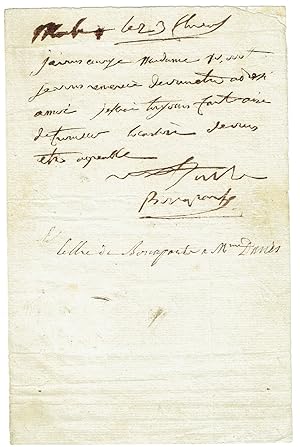napoleon bonaparte (Plus de 30 000 résultats)
Type d'article
- Tous les types d'articles
- Livres (27 888)
- Magazines & Périodiques (246)
- Bandes dessinées (26)
- Partitions de musique (3)
- Art, Affiches et Gravures (980)
- Photographies (552)
- Cartes (48)
-
Manuscrits &
Papiers anciens (823)
Etat
Reliure
Particularités
- Edition originale (4 221)
- Signé (466)
- Jaquette (2 037)
- Avec images (16 355)
- Sans impression à la demande (24 736)
Livraison gratuite
Pays
Evaluation du vendeur
-
Misère de la philosophie. Réponse à la Philosophie de la misère de M. Proudhon.
Edité par Paris & Brussels, A. Frank & C. G. Vogler, 1847., 1847
Vendeur : Antiquariat INLIBRIS Gilhofer Nfg. GmbH, Vienna, A, Autriche
Edition originale
8vo. (VIII), 178 pp. (without the errata leaf). (Bound after) II: The same. Der Achtzehnte Brumaire des Louis Bonaparte. Zweite Ausgabe. Hamburg, Otto Meißner, 1869. VI, 98 pp. Contemporary half calf with marbled covers. Stored in custom-made red half calf solander case with giltstamped spine. Very rare first edition of Marx's famous text, directed against Pierre Joseph Proudhon and the utopian socialists, which led to a long and bitter feud between the authoritarian and the libertarian-anarchist wing. The half title bears Marx's autograph inscription to Anna Vivanti, née Lindau: "Madame Vivanti / Hommage de l'auteur. / Londres, 2 Marx 1872" (the final digit is slightly trimmed by the binder). Anna Vivanti (1828-80), a sister of the well-known German critic, writer and democrat Paul Lindau, had in 1853 married the wealthy silk merchant Anselmo Vivanti, an Italian revolutionary exiled in Britain. The families had known each other for a while: on Christmas Eve 1868 Jenny Marx had described Madame Vivanti in a letter to her sister Laura as "a strange little lady, ugly, deformed, but full of life and spirits [.] She is married to an Italian and is an ardent admirer of Dante, whose poetry she knows by heart. She reminded me so much of the woman Balzac depicts in his Recherche de l'Absolu" (Moscow Russian State Archive for Social and Political History, fond 7, opis 1, delo 11/3). In March 1870 Marx's daughter Jenny had been invited to Norwood to attend a function given by Madame Vivanti, and the 25-year old had a great success with a Shakespearean recitation; later that same year, in October, Anselmo, Anna and their little daughter Luisa had stayed with the Marxes in Hampstead. In 1872 Anna repeatedly tried to solicit from Marx articles for her brother's journal "Die Gegenwart". On 21 March 1872 she thanked Marx for his gift of the book: "[.] I would like to write you a few words about this exceptional book 'Misère de la Philosophie', which I am not a little proud to own, but I have a dreadful cold which makes my head heavy and dumb; also, I would fear to monopolize your valuable time with my silly writing [.]" (translated from German, IISG, D VIII 40 [12073]). - Bound first is the first independent printing of Marx's "The Eighteenth Brumaire of Louis Napoleon", originally published in the May 1852 issue of "Die Revolution". That both works were thus bound together for Anna Vivanti is evident from the binder's pencilled instructions on the final page of the "Misère": "Vivanti / ½ pelle". After Anna's death in 1880 the volume must have ended up in Milan with her widower Anselmo, who died there in 1890 soon after returning to his native country (previously, the widely admired hero of the Risorgimento had long served as President of the New York Chamber of Commerce). Four years later, the philosopher and socialist Antonio Labriola (1843-1904), one of the first propagandists of Marxism in Italy, acquired the volume for 25 lire at a Milan auction, as he reported to Engels in a letter of 3 August 1894: "Ho qui un volume legato, comprato a Milano auzione £25. Contiene oltre al 18 Brumaio, Misère d. l. Ph. originale, esemplare con dedica di Marx a Madame Vivanti (?) 2 (o 4) marzo 1873 (o 72, non chiaro)". It is this letter that led the editors of the Marx-Engels Gesamtausgabe falsely to assume that it was a copy of the "Eighteenth Brumaire" which Marx had inscribed to Madame Vivanti (cf. MEGA I, 11, p. 705). - Corners slightly bumped, but very finely preserved altogether. Both works somewhat browned, the first work more so, with some brownstaining to the title page and traces of an erased ownership stamp (possibly that of Labriola or a previous owner?). Contemporary pencil underlinings in the "Misère", perhaps reading notes by Anna Vivanti. One of the few copies of a Marx work known to have been inscribed by the author to a woman; among other female recipients of inscriptions by Marx are Luise Weydemeyer and Caroline Schoeler ("Das Kapital") as well as Natalja Utina (also the "Misère", with the author's corrections). - Marx-Engels Erstdrucke 11 & 22. Rubel 55 & 215. Goldsmiths' 35456.
-
THE CHRISTOPHER COFFEY COLLECTION OF SPANISH COLONIAL DOCUMENTS AND RELATED ITEMS
Edité par 1543-1929, 1543
Vendeur : Second Story Books, ABAA, Rockville, MD, Etats-Unis
Signé
The Christopher Coffey Collection of Spanish History from 1543-1929 was assembled over the last five years. The collection was purposely assembled to be a chronological representation of important aspects of Spanish domestic and global history and on Spain's colonial control of Cuba and the Cuban Independence movement 1840's-1898. The collection contains three components: Part One consists of 401 Spanish government and colonial documents and 129 royal decrees and letters. They represent every Spanish Royal from the mid 1500's to the early 1920's including Napoleon's brother and King Amedeo. (Total 530 items) Highlights of this section include documents and related items pertaining to the Inquisition and the subsequent outlawing of the Inquisition and torture. There is also a major focus on the Napoleonic and Independence wars including: The creation of the council or regency, The royal creation of the "Dos Mayo" holiday (1811 and 1815), Cadiz Cortez documents, The kidnapping of King Ferdinand 7th/Carlos 4th by Napoleon and his invasion of mainland Spain, The stripping of King Carlos 5th of his right to rule, Captain General (Governor) documents from numerous colonies including Cuba, Puerto Rico and Mexico, and Documents on Florida and the Americas.; Part Two consists of 378 documents, letters, and related items relating to the Cuban Independence era 1840's-1898. It contains two components, the first being 22 Documents and letters including private letters and field promotions from Antonio Maceo, General Maso and Jose Marti (possibly his last letter) and the Spanish account of the sinking of the USS Maine on 16 February 1898. The second related is 356 letters and related items from and to Marta Abreu including awards and honors from her donations including the La Caridad theatre.; Part Three consists of a number of miscellaneous items and serves as an addendum. It includes: 1: 1703 (18 Oct) Saint Ursula COA document. 2: 1796 (23 Feb) Imprint for research on refining sugar. 3: 1801 Blood cleansing research document. 4: 1813 (2 Feb) Royal decree signed by Captain General Apodaca as Governor of Cuba concerning the constitution of 1812 by royal decree. This was the constitution made into law by the Cadiz Cortez in the Kings absence (kidnapping). 5: Seven Documents concerning the Restoration of the 1812 constitution in 1820 and other overseas matters. A soldier's revolt forced the King to reinstate the Constitution which alarmed the other European monarchs. They eventually sent troops to squash the rebellion and restored the Spanish Monarchy to power. 6: 1824 (11 Jan) Overseas exchequer document. 7: 1835 (23 Jul) Royal decree imprint. 8: 1844 (20 Dec) CPT GEN O'Donnell document signed by him and the archbishop. 9: 1853 (29 Jun) Cajas de Ahorro Royal Coffer document. 10: 1863 (31 Aug) Patent packet signed by Count Dulay. 11: 1863 (Oct) Philippine's document packet. 12: Two President Diaz of the Board of Trustees Bolondron Cuba documents: 1871 (10 Feb) President Diaz document and 1886 (9 Jan) President Diaz Junta document. 13: Original photographs and Carte de Visites of Spanish Royals and families, Captain Generals, and USS Maine and members of the crew shortly before the ship sank. 14: Articles and postcards concerning the USS Maine and the raising of it from 1898-1911. 15: A comprehensive history of the Philippine Arch-Diocese of Pangasinan 1771-1939 handwritten by the Bishop of Pangasinan in English, Tagalog and Spanish. 16: Approximately 800 immigration, marriage and genealogical documents relating to Spanish colonies including Cuba, Philippines and the America's dating 1750-1880. The Coffey Collection is being offered only in its entirety, and would be a highlight of any institutional collection. A full inventory list, including images, is available upon request. 1351316. Special Collections.
-
THE RUSSELL COLLECTION: BOOKS, BROADSIDES, AND EPHEMERA OF THE FRENCH REVOLUTION
Edité par 1571 - 1947, 1571
Vendeur : Second Story Books, ABAA, Rockville, MD, Etats-Unis
Edition originale Signé
The Russell Collection contains over 300 books, broadsides, and pieces of ephemera produced between the waning decades of the ancien regime and the fall of Napoleon Bonaparte. The collection was assembled in the early 1950s by William F. Russell (1890 - 1956), President of Columbia University's Teacher's College from 1949 to 1954. With material spanning the 16th to the early 20th century, the majority of the collection was produced between 1775 and 1800. Highlights include early editions of the 1791 and 1793 French Constitutions, letters written and signed by pioneering economist Anne Robert Jacques Turgot, and official documents signed by Robespierre and other members of the Comite du Salut Public. The Collection is comprised of the following components: 1) The French Monarchy and the Ancien Regime; 2) Ideological Roots of Revolution; 3) The Transition to Republicanism and Collapse of the Monarchy; 4) The National Convention and the Committee for Public Safety; 5) Historical and Contemporary Context; and, 6) Miscellanea (Ephemera, Manuscripts, and Books). Most of the printed material was published by one of the two major publishing houses in Limoges. This concentration of material from a single city offers perspective on the publication and distribution of political and governmental texts in a particular city or departement (one which was especially impacted by the Crown's frequently shifting tax and trade policies). It also provides important insight into the early work and career of Anne Robert Jacques Turgot, who served as intendant of Limoges from 1761 - 1774. Limoges was home to several printing houses which, at various times during the Monarchy and Revolution, were designated as official printers of government documents for the region. Most notable among these were the Barbou and Dalesmes families. Both families had been established printers for centuries, but the Barbou appear to have been too closely aligned with the ecclesiastical hierarchy - after 1791, all of the officially published material printed in Limoges was released by members of chez Dalesme. 1) The French Monarchy and the Ancien Regime A significant portion of the collection is made up of documents from the reign of Louis XVI, issued by the crown, members of the regime, and the Parisian Parlement in the two decades leading up to the Revolution. These items, ranging from royal decrees to trial testimonies, illustrate governmental practice under the monarchy, especially as it relates to trade policy and criminal justice. 2) Ideological Roots of Revolution The Russell Collection includes a number of books and tracts from writers crucial to the development of revolutionary thought and discourse in France during the 18th-century. First or early editions by Mirabeau, Raynal, Mounier, Marat, and Condorcet, written before and during the upheavals of the early 1790s, reveal the increasingly liberal and radical intellectual currents among France's intelligentsia. First or early editions of works by Jacques Necker and Turgot also appear, shedding light on abortive efforts at modernization during the various governments under Louis XVI. 3) The Transition to Republicanism and Dissolution of the Monarchy The full span of the National Assembly, from its foundations during the Brienne and Necker governments to its ceding of legislative authority to the National Convention, is captured through official printed documents (Royal and republican), periodicals, regionally-drafted complaints and instructions, and published addresses. Also included are first or early editions of the French Constitutions of 1791 and 1793, as well as various edicts and documents issued by Louis XVI during l'Assemblee Nationale. The formal inauguration of the National Convention (and the removal of all executive powers from the King) is represented both by an Extrait of the relevant Assembly session, and in an officially published broadside explaining "des motif d'apres lesquels l'Assemblee Nationale a proclame la convocation d'un Convention nationale, et prononce la suspension su Pouvoir executive dans les mains du Roi." 4) The National Convention and the Committee for Public Safety; A substantial component of the Russell Collection is comprised of material created by, or related to, the Convention Nationale and the Comite du Salut Public. Nearly 90 official decrees from the legislative body are present, in addition to numerous printed addresses, departmental complaints, and two officially published broadsides related to the trial of Louis XVI. Other highlights include printed decrees and orders from the Committee for Public Safety, a document issued by the Parisian Communards, and an order signed by seven members of the Committee. 5) Historical and Contemporary Context; A subset of the Collection is made up of books and pamphlets responding to the events of the Revolution, from contemporaneous accounts to late 19th-century histories. The works published during the 1790s and early 1800s, whether biographies of revolutionaries or socio-political commentaries, reveal the mix of horror, regret, enthusiasm and hope stirred up among emigres, international observers, and participants in the revolutionary melee. The texts printed after 1840 reflect the intensive, documentary approach of the French historians in the latter half of the century. 6) Miscellaneous Documents (regional, subject-specific, etc.). Also included are a number of items (ephemera and manuscripts) that are either subject specific and tangentially related to the French Revolution (i.e.; treatises on the French language, moral philosophy deduced from botanical studies, 17th century medicine), or specific to Limoges and the Haute-Vienne. The latter includes several 16th and 17th century manuscripts from Limoges and Orleans. Several 20th century books, inscribed to the collector W.F. Russell, appear in the collection as well. All items are in good or better condition, unless otherwise stated. To view.
-
Description de l'Egypte, ou recueil des observations et des recherches qui ont été faites en Égypte pendant l'expédition de l'armée française, publié par les orders de Sa Majesté l'Empereur Napoléon
Edité par Paris Imprimerie Impériale then Royale -1822 -1830, 1809
Vendeur : Shapero Rare Books, London, Royaume-Uni
Livre Edition originale
First edition. 21 vols bound in 20 (9 volumes quarto text, 1 volume elephant folio text [bound with Antiquities vol. I], 11 elephant folio plate volumes), the complete set of 894 plates of which 40 are wholly or partly printed in colours and or hand-coloured, and 2 printed in bistre, many double-page, and or folding, plate DD in Etat moderne II with fore-margin sometime renewed, scattered light foxing, contemporary calf gilt with marbled paper panels to covers (moiré cloth panels to natural history vols.), text volumes rebacked to style, spine gilt lettered and ruled. Antiquities, 5 vols: (I) Engraved frontispiece, map, 99 plates numbered 1-97 (plates 79 and 87 each in two states) + 1 unnumbered plate; Bound with folio text; (II). 92 plates numbered 1-92; (III). 69 plates numbered 1-69 ; (IV). 72 plates numbered 1-72 + 2 plates lettered e & f ; (V). 89 plates numbered 1-89. Etat Moderne, 2 vols. (I). Engraved map, 83 plates numbered 1-83; (II). 22 plates numbered 84-105 + 31 plates numbered I-XXXI + 11 plates lettered A-K + 9 plates lettered AA-II + 4 plates lettered KK-NN + 9 plates lettered a-i + 1 plate lettered k (JJ and j not used). Histoire Naturelle, 2 vols bound in 3: (I). 62 plates; (II). 105 plates; (II bis). 77 plates. Amongst the artists who contributed to this section are Barraband, Bessa, Redoute, and Turpin. Cartes Georaphique et topographique, engraved title & 52 engraved plates. First edition of one of the most ambitious scientific, historical, artistic and publishing projects - a complete set with fine English provenance. The first comprehensive description of ancient and modern Egypt, the outstanding achievement of the savants who accompanied Napoleon's expedition to Egypt (1798-1801). The work is the greatest of a number of outstanding scientific publications by the French government detailing the results of exploration, unequalled by any other nation during the same period. The only flaw in Napoleon's preparations for the invasion of Egypt was a miscalculation when it came to Turkey's reaction to France's unsolicited 'help' in dealing with its mostly unruly vassals, the Mamluks of Egypt. Had it not been for this, Napoleon's plan for following up military conquest by revolutionising the economy and institutions of Egypt might well have created a modern European-style state, controlled by France, at the axis of all the trade routes between Europe, India and the East. Plans to this end involved nearly 500 civilians, the cream of whom were about 150 men drawn from the Institut de France. Once in Egypt their first task was to make a thorough survey of every aspect of the country to assist the planning of its future shape, and this was extended to include Antiquities. The work was co-ordinated by L'Institut de l'Egypte (later replaced by the Commission des Sciences et Arts d'Egypte), founded in the appropriated house of Hassan Kachef (illustrated in the plates to the Etat Moderne), with Gaspar Monge as president. As early as October 1798 Fourier was entrusted with the task of uniting the reports of the various disciplines with a view to publication. Following the capitulation of the army to Egypt under General Menou (a convert to Islam), the savants returned to France where a commission was set up for the editing and supervision of the work. The first volumes were published by Napoleon's government, and it is a measure of how important this work was considered to be that publication continued following the Bourbon restoration. '. never before or since has a study of such scope and thoroughness been accomplished on the basis of field work carried out in so short a space of time and under such inadequate and harrowing circumstances' (J.C. Herold, Bonaparte in Egypt, 1963). Antiquities describes not only the ruins, but also the objects excavated, including the Rosetta Stone, here described for the first time. The quality of the plates was much enhanced by the use of an engraving machine invented by Conte, which is itself illustrated among the plates. Etat Moderne describes the architecture of Egypt subsequent to the Arab invasion in the seventh century, particularly Cairo, as well as sections on Art et Métiers, Costumes et Portraits, Vases, Meubles et Instruments, and Inscriptions, Monnaies et Médailles. Algernon Percy, 4th Duke of Northumberland was the second son of Hugh, the second Duke, a distinguished naval officer and a man of science and learning, he rose to the rank of Admiral, and was First Lord of the Admiralty in 1852. He became Duke of Northumberland in 1847, and a Knight of the Garter in 1852. Atabey, 343; Blackmer, 476; Brunet II, 616-617; Nebenzahl, Maps of the Holy Land, 60; Nissen, BBI, 2234; Nissen, ZBI, 4608; Wilbour pp178-185.
-
Description de l'Egypte. Ou Recueil des observations et des recherches qui ont été faites en Egypte pendant l'expédition de l'armée française. Imperial Edition, complete set of plates in 11 volumes
Vendeur : Meretseger Books, Paris, France
Extremely rare and in prime condition. Located in Paris. Complete set of 11 volumes of plates, the Imperial Edition published in Paris on the orders of Napoleon I, first by the Imprimerie Impériale, between 1809 and 1813, then by the the Imprimerie Royale from 1817 to 1829. 11 volumes, elephant folio (70 x 54 cm). The set is complete with 894 plates, of which 45 are coloured (32 in the Antiquités volumes and 13 in the Histoire Naturelle volumes). First 8 volumes (5 x Antiquités, 2 x Etat Moderne, 1 x Carte topographique) in a magnificent mid-19th century full-leather binding with elaborate gilding, made in England. The last 3 volumes (Histoire Naturelle) are bound in a modern full-leather imitating the first 8 volumes "à l'identique". All volumes have the edge of pages gilded on all three sides. The plates are in fine condition, with very limited foxing on a few plates only and limited to the edge. In Etat Moderne tome II, Plates i and k have a small humidity stain on bottom right margin not affecting the drawings. Altogether in exceptionally fine condition. The set has been collated and is complete, as follows: Volume I (Antiquités, tome I, 1809): Frontispice, Page de Titre, Explication du Frontispice, Préface Historique (pages i à xcii), Avertissement (pages 1 à 8), Explication des Planches (28 unnumbered pages on 14 leaves), carte, Planches 1 to 97 (15, 16, 18, 44 & 70 in color) + an additional Plate 79a + a Plate A after Plate 95 (there are two Plates 79a, one of which is a line drawing of the other. After Plate 95, there is a Plate A, which is a line drawing) (total: 100 plates). Volume II (Antiquités, tome II, 1812): Explication des Planches (41 unnumbered pages on 21 leaves), Planches 1 to 92 (12, 37, 47, 48, 49, 50, 52, 58, 59, 72, 73, 74, 75, 82, 83, 86, 87, 88, 89, 90, 91, 92 in color). Volume III (Antiquités, tome III, 1812): Explication des Planches (21 unnumbered pages on 11 leaves), Planches 1 to 69 (11, 12 & 34 in color). Volume IV (Antiquités, tome IV, 1817): Avertissement, Explication des Planches (33 unnumbered pages on 17 leaves), Planches 1 to 72 (12 & 62 in color). 2 Plate marked A: one after Plate 19, one after Plate 20 (total: 74 plates). Volume V (Antiquités, tome V, 1822): Explication des Planches (44 unnumbered pages on 21 leaves), Planches 1 to 89 (none in color). Volume VI (Etat Moderne, Tome I, 1809): carte + planches 1 à 83 (the map on plate 26 has some red tracings delimitating the areas) (total: 84 plates). Volume VII (Etat Moderne, Tome II, 1817): planches 84 à 105 + Arts et Métiers: planches I à XXXI + Costumes et Portraits: planches A à K + Vases, Meubles et Instrumens: planches AA to NN (without JJ, never published) + Inscriptions, Monnoies et Médailles: planches a to k (without j, never published) (total: 88 plates). Volume VIII (Histoire Naturelle, tome I, 1809): Mammifères: Planches 1-7 + Mammifères Planche 1 (supplément); Oiseaux: Planches 1-14; Reptiles: Planches 1-8; Reptiles Planches 1-5 (supplément); Poissons: Planches 1-27 (total: 62 plates). Volume IX (Histoire Naturelle, tome II, 1817): Céphalopodes: Planche 1; Gastéropodes: Planches 1-3; Coquilles: Planches 1-14; Annélides: Planches 1-5; Crustacés: Planches 1-13; Arachnides: Planches 1-9; Myriapodes (et Hexapodes-Aptères): Planche 1; Orthoptères: Planches 1-7; Névropteres: Planches 1-3; Hyménoptères: Planches 1-20; Echinodermes: Planches 1-9; Zoophytes: Planches 1-3; Ascidies: Planche 1; Polypes: Planches 1-14); Algues: Planches 1-2 (total: 105 plates). Volume X (Histoire Naturelle, tome II bis, 1826): Botanique: Planches 1 to 62 (59 in color); Minéralogie: Planches 1-15 (1-5, 7-9, 12-15 in color) (total: 77 plates). Volume XI (Carte Topographique, 1828): Map of Egypt + Table + Feuille 1-5 + Feuille 1-47 (total: 54 plates). After giving up on the planned invasion of the British Isles in 1797, Bonaparte wrote to Bourienne : "If the success of an invasion of England looks doubtful, as I fear it, the Army of England will become the Army of the Orient, and I go to Egypt". The Institut National de France had been founded in 1795 with the aim of "collecting. the discoveries, improve arts and sciences". An expedition to Egypt was proposed by Talleyrand and despite the resistance of the Directoire, the expedition of the Orient was finally constituted on April 12th, 1798. Napoleon left with 280 ships, 54,000 men and the best generals, not only his companions of the Italian campaign: Berthier, Murat, Lannes, Davout, Marmont, Duroc, but also with Kléber and Desaix. Bonaparte had a true interest in sciences: he had been elected a member of the Institut National in the section for physical sciences and mathematics. Monge, Berthollet, Fourier, Geoffroy-Saint-Hilaire. altogether 150 scholars joined enthusiastically the Commission des Sciences et Arts de l'Armée d'Orient. In this commission, all branches of science were represented, thus a large scientific and artistic material was put on board of the ships in Toulon: laboratory of physics, aerostation material, chemistry cabinet, surgical instruments, as well as a printing press. While the military expedition resulted in a disaster, the results of the scientific and artistic work gave birth to the Description de l'Égypte. Published over more than 20 years mostly by the scholars and artists who had taken part in the Expédition, the Description de l'Egypte became the largest and most beautiful publication of the 19th century. Language: French. This set ships from Europe, shipping costs will be updated accordingly (PHM). Relevant subjects: Egypt: Travelers & Egyptologists, Old Kingdom & 1st IP, Middle Kingdom & 2nd IP, New Kingdom, 3rd IP, Greco-Roman, Language, Texts & Writing, Pyramids, Tombs, Temples & Towns.
-
Der 18the Brumaire des Louis Napoleon [in: Die Revolution, eine Zeitschrift in zwanglosen Heften. Herausgegeben von J. Weydemeyer. Erstes Heft]. - [THE MOST IMPORTANT PROPOSITIONS IN THE MARXIST TEACHING ON THE STATE]
Vendeur : Lynge & Søn ILAB-ABF, Copenhagen, Danemark
Membre d'association : ILAB
Edition originale
New-York, 1852. Bound in a later (ab. 1900) red full cloth binding with silver lettering to front board. A bit of wear to capitals, corners, and extremities. Front free end-paper with small repairs and strengthening. A couple of closed tears to blank outer margin of title-page (no loss and not affecting printing)Inner blank margins of the first few leaves strengthened (far from affecting text). Occasionally a few marginal notes. and underlinings. A near contemporary notice in Russian about the work has been inserted between the title-page and the preface. All in all a good copy with no major flaws. IV, (4), 62 pp. The exceedingly scarce first edition of one of the absolutely most important writings by Marx - his seminal essay on the French coup of 1851, which not only constitutes our principal source for the understanding of Marx' theory of the Capitalist state (together with "The Civil War in France"), but which is also the work in which Marx formulates for the first time his view of the role of the individual in history."This work (i.e. "The Eighteenth Brumaire"), written on the basis of a concrete analysis of the revolutionary events in France from 1848 to 1851, is one of the most important Marxist writings. In it Marx gives a further elaboration of all the basic tenets of historical materialism - the theory of the class struggle and proletarian revolution, the state and the dictatorship of the proletariat. Of extremely great importance is the conclusion which Marx arrived at on the question of the attitude of the proletariat to the bourgeois state. He says, - "All revolutions perfected this machine instead of smashing it.". Lenin described it as one of the most important propositions in the Marxist teaching on the state. In The Eighteenth Brumaire of Louis Bonaparte Marx continued his analysis of the question of the peasantry, as a potential ally of the working class in the imminent revolution, outlined the role of the political parties in the life of society and exposed for what they were the essential features of Bonapartism." (note 1 in the Preface to the Third German Edition (Engels, 1885) )."The Eighteenth Brumaire of Louis Napoleon" was written between December 1851 and March 1852 and originally published - as it is here - in 1852 in "Die Revolution", a German monthly magazine established by Joseph Weydemeyer and published in New York. In this cornerstone of modern political thought, Marx discusses the French coup of 1851 in which Louis-Napoléon Bonaparte assumed dictatorial powers and does so by treating actual historical events from the viewpoint of his materialist conception of history.Marx states that his purpose with the work is to "demonstrate how the class struggle in France created circumstances and relationships that made it possible for a grotesque mediocrity to play a hero's part" (preface to the second edition, 1869), and he famously formulates his view of the role of the individual in history ("Men make their own history, but they do not make it as they please" they do not make it under self-selected circumstances, but under circumstances existing already, given and transmitted from the past").If one wants to understand Marx' views on the capitalist state, "The 18th Brumaire" is absolutely essential, as it is to the understanding of the nature, the rise, and the meaning of fascism. Among Marxist scholars, there's wide consensus about regarding Louis Bonaparte's coup and rise to power as a forerunner of the fascism that is to emerge the 20th century. In the words of Engels: "The fact that a new edition of "The Eighteenth Brumaire" has become necessary, thirty-three years after its first appearance, proves that even today this little book has lost none of its value. It was in truth a work of genius. Immediately after the event that struck the whole political world like a thunderbolt from the blue, that was condemned by some with loud cries of moral indignation and accepted by others as salvation from the revolution and as punishment for its errors, but was only wondered at by all and understood by none-immediately after this event Marx came out with a concise, epigrammatic exposition that laid bare the whole course of French history since the February days in its inner interconnection, reduced the miracle of December 2 to a natural, necessary result of this interconnection and in so doing did not even need to treat the hero of the coup d'état otherwise than with the contempt he so well deserved. And the picture was drawn with such a master hand that every fresh disclosure since made has only provided fresh proofs of how faithfully it reflected reality. This eminent understanding of the living history of the day, this clear-sighted appreciation of events at the moment of happening, is indeed without parallel. .In addition, however, there was still another circumstance. It was precisely Marx who had first discovered the great law of motion of history, the law according to which all historical struggles, whether they proceed in the political, religious, philosophical or some other ideological domain, are in fact only the more or less clear expression of struggles of social classes, and that the existence and thereby the collisions, too, between these classes are in turn conditioned by the degree of development of their economic position, by the mode of their production and of their exchange determined by it. This law, which has the same significance for history as the law of the transformation of energy has for natural science - this law gave him here, too, the key to an understanding of the history of the Second French Republic. He put his law to the test on these historical events, and even after thirty-three years we must still say that it has stood the test brilliantly." (Preface to the Third German Edition (Engels, 1885)).The work is incredibly scarce. OCLC lists no more than two copies in libraries world-wide: One in the USA: University of Wisconsin, one in France.
-
The Illustrated London News
Edité par The Illustrated London News 1842-1910, London, 1842
Edition originale
Cloth. Etat : Good. Various (illustrateur). First edition. A vanishingly scarce continuous run of the highly influential Victorian periodical The Illustrated London News, replete with many highly desirable folding plates and illustrations and covering some of the most important events of the nineteenth century. Folio. A vanishingly scarce continuous run, being volumes 1-138 published between 1842 and 1910. In the original highly decorative publisher's cloth binding. Copiously illustrated throughout in colour and monochrome, with many of the highly sought after city panoramas including Edinburgh, Dublin, Paris and Rome present. As is common with this work, many of the folding plates have been removed, however, the work is still highly illustrated throughout with many of the folding plates and panoramas remaining. The highly sought after July-December 1878 volume, known as the Cyprus volume, is present. Please note that due to the scale of the set, a complete collation is not available here, although we would be happy to offer further information and collation as required. The Illustrated London News was the world's first illustrated weekly newspaper; the first issue appeared on Saturday 14 May 1842. Printer and newsagent Herbert Ingram moved from Nottingham to London in early 1842. Inspired by how the Weekly Chronicle always sold more copies when it featured an illustration, he had the idea of publishing a weekly newspaper that would contain pictures in every edition. By 1863 The Illustrated London News was selling more than 300,000 copies every week, enormous figures in comparison to other British newspapers of the time. The work rose to fame following its publication of the designs for the Crystal Palace in 1851 and of the funeral of the Duke of Wellington.The work is credited with moving illustrations from purely a satirical device in mainstream news, to a credible and factual reporting tool, publishing over 750,000 illustrations during its existence. Important historical moments to these volumes include The Great Exhibition of 1851, 'The New Church of St Nicholas, Hamburg' Queen, Queen Victoria visiting Germany, The Beethoven festival, Pilbrow's atmospheric railway, the burning of the Bowery Theatre New York, the funeral of the Duke of Cambridge, 'Visit of the Queen and Prince Consort to The Emperor Napoleon at Paris 1855 ', Sir Allen William Young's 1876 expedition on the 'Pandora' for which he received a knighthood in recognition of his services, the death and funeral of the Prince Imperial, Louis-Napoleon Bonaparte, The Phoenix Park Murders and the departure of Sir John Franklin on what is now known as his 'Lost Expedition' to the second volume at page 328. There is also extensive coverage of the Zulu war and other military conflicts in addition to the sections of sheet music and general newspaper puzzles. Volume LVI contains notable articles including the plans for the proposed Channel Railway Ferry, plans relating to The Amsterdam Ship Canal and the obituary for influential Private Secretary General Charles Grey. Volume LVII is notable for its discussion on the Franco-Prussian war of 1870, including a portrait and article relating to General Vogel Von Falkenstein, a Prussian General der Infanterie. The work also contains an engraving of the Town of Mezieres, which was greatly impacted by the conflict and wounded soldiers in the Gardens of Versailles. The work also contains a charming two page engraving showing the Opening of the Thames Embankment. An impressive continuous run of the highly influential Victorian periodical, The Illustrated London News, containing many highly important references to British history, as well as many charming and highly desirable plates. In the original publisher's cloth binding with gilt detail. Volume 2 of 1874 has been rebound in morocco. Externally smart with rubbing to the joints and extremities. Marks to the occasional board. The very occasional volume, including volume 55 is lacking the back strip although the majority remain present and very smart. The occasional patch of damp staining to the boards, including to volumes 57, 59 and 44. Due to the weight of the volumes, hinges are strained. Text block detached from binding to volume 102. Internally most volumes are generally firmly bound. Pages are generally bright with age toning and scattered spotting heavier to the extremities and the fore edge. The occasional volume has significant closed tears, including closed tears and loss to volumes 55. Writing to the fore edge of volume 55. The occasional tide mark, including to volume 44. Loss and closed tears to several of the folding plates and panoramas. Many pages are closely cropped with the occasional loss to the text. Many plates, including plates and panoramas have been removed. Additional condition notes can be sent across at request. Good. book.
-
Le Musée Français.
Edité par Paris, Herhan, 1803-1809., 1809
Vendeur : Antiquariat INLIBRIS Gilhofer Nfg. GmbH, Vienna, A, Autriche
Edition originale
Large folio (570 x 320 mm). 4 vols. With 4 engr. title vignettes, 8 engravings in the text, and 344 engr. plates. (And:) Laurent, H., Musée Royal. Paris, Didot, 1816-1818. 2 vols. With engr. title vignette, 4 engravings in the text, and 161 engr. plates. (4), 28 pp. 113; 85 ff. A total of 6 vols. in contemp. dark-green morocco, sumptuously gilt, with giltstamped coat of arms on covers. First edition; the best documentation of the famous Louvre's holdings and collections, here complete with all illustrations. A splendid copy including all the supplements, uniformly bound in gilt green period morocco for Charles Ferdinand d'Artois, duc de Berry (1778-1820) and his wife Marie-Caroline of Naples and Sicily (1798-1870), with their marriage arms (1816); their "Bibliothèque de Rosny" bookplate is on the pastedown. - A few plates misbound; occasional staining. Published in only 600 copies, "Musée Français" was dedicated to Napoleon Bonaparte. The supplement, published after the Emperor's abdication, was dedicated to the King. - A magnificent set of this great work in perfect state of preservation and from a noble library. - Cohen/R. 743. Vicaire V, 1229.
-
Original, Unpublished Notes for Napoleon's Invasion of Russia, Prepared for the Invasion, from the Archives of Napoleon's Senior Aide de Camp Charged with Planning that Invasion (Sent at Napoleon's direction to General Georges Mouton, the remarkable, 14-page manuscript gives directions to a prospective invading army, listing populations, topography, opportunities for provisioning, bridges to cross, etc.)
Vendeur : The Raab Collection, Ardmore, PA, Etats-Unis
It is based on an 1809 intelligence operation that Napoleon commissioned to chart Persia, Russia and the steppes?A remarkable and apparently unpublished manuscript documenting Russia and its environs in the early 1800s, fascinating for that purpose as well?Acquired from the direct descendants and never before offered for sale"Resistance could only result in the burning by the assailant of a large part of the wooden houses of Moscow"?"Minsk is a town of 10,000 inhabitants of which two thirds are Jewish."?https://vimeo.com/916160568?share=copyIn 1803, Camille Alphonse Trezel obtained the rank of lieutenant in the corps of topographical engineers. The next year he was promoted to assistant engineer geographer. After the Polish campaign, as a lieutenant, he was appointed acting aide to General Gardanne, in the embassy of France to Persia. He was commissioned at this time by Napoleon to take extensive notes, topographical, geographical and otherwise of Persia and its environs. On his return, he came through Russia. On his return to France, he was promoted to Captain in late 1810 / early 1811 and assigned as an aide-de-camp to General Armand Charles Guilleminot; he became lieutenant-commander in 1813. Napoleon aimed to defeat not only Russia but England, and the latter in part through India. Trezel and Gardanne in 1809 were tasked to survey the vast regions that would have to be crossed and to probe the dispositions of the populations, and as evidenced here, did so.Trezel's notes on Persia are published and important primary resources for the period and region. We found no record of the publication of his notes on Russia.In May and June 1812, Napoleon turned to mapping the pending invasion of Russia and finding the correct route. He had few great options. As the published papers of Napoleon state, "Despite the efforts of his geographical engineers, Napoleon never had good maps of Russia throughout the campaign. To compensate for this shortage, the Paris topographical office should have drawn large numbers of the few available maps and given them to the corps commanders. This was not done on the scale that the emperor wanted.? He complained during this stretch that he needed more routes to Russia, that one would not suffice for planning, and he wrote to Generals Clarke and Berthier complaining on this subject.On June 24, 1812 Napoleon commenced his famed campaign in Russia, ordering his Grande Arm?e, the largest European military force ever assembled to that date, into Russia. The enormous army featured more than 500,000 soldiers and staff and included contingents from Prussia, Austria, and other countries under the sway of the French empire. The campaign would be characterized by the massive toll on human life: in less than six months Napoleon lost near half of his men because of the extreme weather conditions, battle, disease and hunger. On both sides, nearly a million soldiers and civilians died.General Mouton, the Count of Lobau, was a prominent general and later Marshall of the Empire for Napoleon. Mouton means "lamb" in French, the source of Napoleon's now famous statement on Mouton: "My lamb is a lion." Napoleon valued Mouton to the extent that for his great Russia campaign he made him senior aide to camp. In 1806 Mouton was a Brigade General. He would remain in Napoleon's service until the end of the Empire, during which time he showed himself to be forthright, direct (?he's no fawner?, Napoleon is noted to have said) but also disciplined, loyal, meticulous and highly organized. He was at Austerlitz with Napoleon and was charged with the preparation of the campaigns in Spain (1808), Russia (1812), Germany (1813), and Belgium (1815). Napoleon also wrote ?Mouton is the best colonel to have ever commanded a French regiment.? In 1812 Mouton took an active part in the planning and enacting of the Russian campaign. When Napoleon left the army during the retreat and returned to Paris, Mouton accompanied him.Manuscript, in the hand of an intelligence officer, likely from the topographical department, from the Library of Georges Mouton, no date but likely late Spring 1812. The manuscript notes the position of Trezel as Captain and aide to camp for Guilleminot, a position Trezel effectively occupied between 1811 and 1812. It appears to be a shortened version of the report from the 1809 intelligence operation that Napoleon commissioned. Our gratitude to the Fondation Napoleon for their generous assistance."Notes on the Route from Warsaw to Moscow by Tykoezinn frontier of the Grand Duchy [of Warsaw] (47 leagues), Grodno (77 leagues), Mir (133), Mink (158), Orzay (208), Smolensk (237) and Moscow (333). Extracts from a voyage made in July 1809 by Captain Trezel, aid de camp of General Guilleminot."The following are quotes from the report:"The country between Warsaw and Moscow can be divided in three distinct parts separated from each other by large rivers or by old political limits recent changed by a great usurpation but which remains in the hearts of the inhabitants of old Poland."The first part enclosed by the Vistule and the Niemen has 77 leagues of length, and the Neiman has 77 leagues of length. The route that goes through it passes by a good number of little towns, among them, the towns of the route that goes through it passes by a good number of little towns, among them, the towns of Siroska, Pultuska, Ostrolenka, and Byalistok are the largest."?"The second from Grodno to Orzay has 125 leagues. It includes old Palatinate of Troki, Minsk, part of that of Vitebsk, all the high parts of the Niemen and also those of the Dnieper to the right bank of the Pleure beyond which starts the Russian government of Smolensk. The route passes by the towns of Norogrodek, Mir, Minsk, Barisow, Toloezinn, Orzay and Doubrovka."The third part between Smolensk and Moscow is entirely in old Russia. It's length by the route is 131 leagues. One finds in succession, the towns of Dorogouer, Viarnie, Gradsk, and Moyaiska.
-
Napoleon, With this Document, Launches the Napoleonic Era (Napoleon, During the Siege of Toulon, Gathers the Munitions for the Final Assault, In a Victory that Would Commence His Career and Change the Face of the Globe Forever)
Vendeur : The Raab Collection, Ardmore, PA, Etats-Unis
Written just days after his first ever promotionOne of only 4 documents of Bonaparte, stretching back a century, we can find during the siege, signed with the early Italian form his signature, BuonaparteThe French Revolution had not only overthrown a monarch, it had pitted Europe against France. Austria and more distantly England saw a revolutionary France as a transcendental threat. So as Paris was engaged in a massive upheaval, it faced an ongoing state of hostilities with its neighbors. This led to a series of executive governments, the most famous of which was the Committee of Public Safety, established in April 1793, after the King had already been beheaded. In July of that year, Maximilien Robespierre was elected to the Committee; and so under his leadership began the Reign of Terror, so named because terror was in fact a policy instrument recognized by the state as an extension of the Revolution, which must be maintained at all costs. This control extended everywhere; they controlled the police and the army, and their agents went nationwide to do Robespierre?s bidding.Among the gravest threats to the new government under Robespierre was the royalist sentiment in the South along the coast, which just so happened to be within reach of the British Royal Navy. Here, in open defiance of the Republicans, royalists hoisted the ?flour de lys? flag in the fall of 1793 in the city of Toulon. By that time, French troops were already on their way to that city where they would confront 13,000 men from the combined forces of England, Spain, Naples and Piedmont. The French generals were in control of their troops, but Robespierre also sent to this key battleground his brother, Augustin, and Antoine Saliceti, a Corsican like Napoleon, and like him close to the French cause. These two were to report on the loyalties of generals, the extent of success, and to advise Paris in all matters. They had final say in the South, and in reality controlled life and death.At the time when the siege of Toulon began, the Chief of Artillery was wounded, and since Toulon would require a strong bombardment, this deficit had to be filled. Napoleon Buonaparte (as he spelled his name then) had until then mainly been involved in provincial battles in his native Corsica. He was a relative unknown in France, and had no high title, although he had studied in the military academy there and was in service to the national army. His family had in fact fled Corsica because of its allegiance to France. In what may go down as one of the great coincidences in history, he happened to be in the area as the French gathered for the assault on Toulon and was given the command of artillery by Augustin Robespierre and Saliceti, whom he knew from Corsica. This seemingly insignificant event at the time would make his career and changed the history of Western Europe.The siege itself began in mid September. He was dissatisfied by the sole battery?called the "Mountain", positioned on the height of Saint-Laurent since September 19. He established another, on the shore of Br?gallion, called the "sans-culottes". On the first of October, after a failure of General La Poype against the "Eastern Fort" of Faron, Bonaparte was asked to bombard the large fort of Malbousquet, whose fall would be required to enable the capture of the city. He therefore requisitioned artillery from all of the surrounding countryside. Promoted to Chief of Battalion on October 18, he set about strengthening his battery for the great push.Document signed, October 23, 1793, Ollioules near Toulon, signed Buonaparte, an early, Italian form of his signature, just days after being promoted to Chief of Battalion. "Statement of the pieces of artillery and other necessary effects to complete the army for the Siege of Toulon." The document continues us columns to note the type of weapon, what would be necessary, what they have now, and what is missing, along with any observations.Napoleon performed with great skill and Toulon was taken, a significant defeat to the royalists and to England. Buonaparte was credited with French success. Where soldiers who failed Paris were guillotined, those who won were feted and promoted. Augustin reported back to his brother Maximilien Robespierre that Napoleon was an exceptional commander. The elder brother decided that he would be named brigadier general in December 1793.
-
Vues des champs de bataille de Napoléon en Italie dans les années 1796, 1797 et 1800. Dessinées sur les lieux par M. Bagetti, capitaine ingénieur-géographe. Gravées et terminées au Dépôt de la Guerre, sous la direction de M. le Lieutenant-Général Pelet
Edité par Paris, 1835, 1835
Vendeur : Librairie Historique F. Teissèdre, PARIS, France
Membre d'association : ILAB
in-plano (68,5 x 52 cm), [4] ff. n. ch. (titre et table des planches), et 68 grandes planches à double page, gravées par Perdoux, Desaulx, Cardano, Misbach, Schroeder, Lameau, Fortier, etc., d'après les dessins de Bagetti ; le tout monté sur onglets demi-maroquin vert, dos lisse Taches et rousseurs à certaines planches, trace de pliure à la page de titre. (reliure à l'imitation). RARISSIME SUITE DE VUES MILITAIRES sur les campagnes d'Italie, représentant les villes, bourgs et champs de bataille qui furent le théâtre des opérations dans les deux campagnes d'Italie menées sous la direction de Bonaparte.Bien complet de la planche 40bis, annoncée à la table, et représentant le bourg de Bignasco.Elle ne figure pas dans les exemplaires des dépôts publics qui annoncent tous 67 planches.L'exemplaire du Prince de la Moskowa qui est passé entre nos mains ne comportait pas non plus cette planche.L'intérêt de ces vues n'est pas seulement historique, car elles témoignent d'une utilisation déjà romantique du paysage et de la nature comme arrière-plan et en même temps signe de l'activité humaine qui s'y déroule, à savoir ici la guerre : car les lieux, naturels ou construits, admirablement reproduits, n'y forment pas seulement un décor, mais annoncent et représentent l'action dont ils sont partie prenante, résultat d'autant plus surprenant que, à la différence d'autres scènes non italiennes, l'artiste ne fut pas sur les lieux au moment des combats, mais reprit, quelques années plus tard, les scènes par des esquisses crayonnées souvent assez sommaires, comme on le verra ci-après. L'on pourra contempler longuement les villes, et les quelques monastères qui sont représentés (comme le Saint-Bernard) : la vérité du paysage italien est frappante pour celui qui a eu l'occasion de déambuler, en touriste, aux heures chaudes, dans les plaines du nord du pays, ou d'aborder une ville, un bâtiment, repliés sur leur torpeur.Le Piémontais Giuseppe Pietro Bagetti (1764-1831), peintre paysagiste et ingénieur-géographe, eut deux carrières successives. La première, au service de Victor-Amédée III, Roi de Sardaigne, son souverain naturel, qui avait tôt remarqué son talent, lui permit d'accompagner, à partir de 1793, les troupes piémontaises stationnées dans le Comté de Nice puis envoyées à Toulon au moment de l'occupation de ce port par les Anglais. A son retour, il fut chargé d'enseigner la topographie militaire à l'Ecole du Génie de Turin. C'est à ce titre qu'il assista, mais de loin, à la première campagne d'Italie, et à la conquête du Piémont par les Français.Sa seconde carrière commence à la fin de fructidor an VIII [septembre 1800] quand, sur la proposition des généraux Dupont et Oudinot, il entra au Cabinet historique et topographique, dirigé par l'adjudant-général Brossier. Affecté au cours de l'an IX auprès de l'Armée d'Italie comme capitaine ingénieur-géographe, sous les ordres du général Brune, il dut y exécuter, d'après nature et sous la direction de Joseph-François-Marie Martinelli, dit de Martinel, une série d'aquarelles relatives aux actions militaires des deux campagnes italiennes sous les ordres de Bonaparte. En réalité, sur place, l'artiste se contentait de prendre des croquis rapides et quelques notes ; c'est une fois revenu à Paris que Brossier lui donnait des directives précises pour la réalisation des scènes, souvent émanées de Napoléon lui-même, très attentif, comme l'on sait, à suivre l'exécution des oeuvres racontant sa gloire. La plupart de ces aquarelles originales se trouvent actuellement au Château de Versailles, et ce depuis 1834 et la constitution des collections du Musée de l'histoire française voulu par Louis-Philippe.Bagetti travailla ainsi pendant huit ans et acheva environ 80 tableaux commandités, pas seulement sur la période italienne de Bonaparte (il avait par exemple suivi l'Empereur à Austerlitz, en Russie, et y exécuta aussi des vues). Bien après la fin de l'Empire et le retour de Bagetti à Turin (1815), ce furent 67 des vues des champs de bataille italiens qui furent publiées sous l'ordre du lieutenant-général Pelet, et elles forment le recueil exceptionnel que nous présentons, lequel semble n'avoir connu qu'un assez faible tirage.Trois exemplaires au CCF (BnF, Sainte-Geneviève, Lyon). Cf. La Liberté en Italie vue par les artistes du Dépôt de la Guerre (catalogue d'exposition du Service historique de l'Armée de Terre, 1996).
-
Essai politique sur le royaume de la Nouvelle-Espagne
Edité par F. Schoell, Paris, 1811
Vendeur : Arader Galleries - AraderNYC, New York, NY, Etats-Unis
Edition originale
3 volumes: 2 volumes text, 4to., (13 4/8 x 10 inches); and atlas volume, folio (22 x 16 inches). Half-titles in each volume. With the dedication leaf and 4-page dedication to Charles IV. 21 engraved maps, profiles, views, and charts on 19 sheets, four hand- colored (some intermittent pale spotting.) Modern tan calf-backed black marbled paper boards, spines gilt, by Atelier Laurenchet. Provenance: Bookplates of Jay T. Snider, Collection of Historical Americana. First edition, a very rare variant. Yale has a copy of the true first edition with an 1808 title-page and the dedication leaf to Charles IV. The present copy is dated 1811 in the text volumes, but is actually made up of the text as printed in 1808, including the suppressed dedication leaf to Charles IV of Spain. This copy, with the same format and pagination but with the suppressed dedication, shows that the 1811 edition was actually made from the sheets of the 1808 printing, with the dedication removed and the 1811 titles inserted. This edition has generally been overlooked by bibliographers (although Thomas Streeter correctly described the accompanying atlas and surmised this text might exist), the 1809-1814 Tübingen edition generally described as the first. Evidently published in the spring of 1808, the present edition is markedly different in text from that which began to appear the next year. It was suppressed, probably by Humboldt himself. He dedicated the work to Charles IV of Spain, who had allowed him to travel freely through the Spanish colonies. Almost concurrently with the book's publication, Napoleon invaded Spain and deposed Charles, installing his own brother, Joseph Bonaparte, on the Spanish throne. Already under suspicion as a Prussian spy and only allowed to remain in Paris through the intercession of his scientific friends, Humboldt's dedication to the abdicated monarch might have sealed his fate. He may also have had second thoughts about the scope of the work, as the Tübingen edition is greatly enlarged. In 1799 Alexander von Humboldt went to Spain and received from the king permission to visit and make scientific investigations in all the Spanish possessions in Europe, America, with privileges never before granted to any traveller. From 1799 to 1804, Humboldt was accompanied by the French botanist Aimé Bonpland, and together they made observations on geology, geography, zoology, botany and the political and social character of the regions. His exploration of Orinoco River was the first to furnish any positive knowledge of that river. In 1802, in exploring the volcanoes of Ecuador, he ascended heights that had not previously been attained, and on Chimborazo reached the altitude of 19,286 feet. Afterward he made a profile of Mexico from sea to sea--this was the first profile ever given of an entire country. After his return to Paris, and over a period of about two decades, Humboldt undertook to publish the results of his study in the monumental 29-volume "Voyage aux regions equinoxiales du Nouveau Continent". The present work is the third part of this series, consisting of two text volumes and an atlas of maps relating to New Spain, including much of present-day southwestern United States. This comprised the first scientific description of the American Southwest and includes a wealth of new information on California and Texas. The atlas includes plates on volcanoes, land profiles, a map of the southern part of North America, maps of Mexico and many of its parts, and most importantly, Humboldt's two-sheet "Carte Generale du Royaume de la Nouvelle Espagne." This map contained the most up-to-date geographic depiction of Texas, California and the rest of Mexico, and it became the prototype rendering for much of the region for the next several decades. Carl Wheat called the map a "truly magnificent cartographic achievement." Cowan p. 296 (another edition); Graff 2009; Hill p. 149 (another edition); Phillips 2682; Reese & Miles Creating America 23; R For.
-
Vues et Paysages des Régions Équinoxiales, recueillis dans un voyage autour du monde, avec une introduction et un texte explicatif.
Edité par Paris: Paul Renouard, 1826., 1826
Vendeur : Arader Galleries - AraderNYC, New York, NY, Etats-Unis
Edition originale
Folio (16 x 11 inches). 24 hand-colored lithographic plates by Choris (some spotting and browning to text, very minor light spotting to plates 1-4, 11 and 24, occasional faint offsetting). Contemporary French crimson straight-grained morocco-backed red paper boards (minor rubbing, corners bumped), smooth spine gilt, monogram and crowned cipher of Marie-Lousie, former Empress of France, stamped in gilt at the head of the spine. Provenance: Gilt monogram on binding of Marie-Louise of Austria (1791-1847), Empress of the French (1810-1814), thereafter Duchess of Parma; bookseller's ticket of John Howell, San Francisco, on rear paste-down; Talfourd P. Linn, lawyer and bibliophile, whose celebrated collection of Cervantes is now housed at Ohio State University. First edition, from the library of Marie-Louise, second wife of Napoleon Bonaparte. Choris's sequel to "Voyage pittoresque autour du monde", 1820, and dedicated to the tropical regions visited Kotzebue's voyage in the "Rurik" to the Pacific, 1815-1818. Inspired by Alexander von Humboldt, to whom the work is dedicated, and especially to his "Tableaux de la nature", Choris envisaged this edition as a series of "tableaux" revealing the characteristics of each region, with their local fauna, flora and inhabitants. The plates are remarkable for their realism and testify to Choris's superb draftsmanship and sure touch for revealing details. Places depicted include Tenerife, Brazil, several Pacific islands, including Easter Island (where the travelers were prevented from landing by irate inhabitants following a recent abduction by two native women), the newly discovered isle of Romanzov (named for the expedition's sponsor, now Wotje Island, in the Marshall Islands), with its spectacular coral reefs; Hawaii, and the Philippines; Kamchatka, the Cape of good hope and Saint Helena, the island of Marie-Louise's Bonaparte's exile. Catalogued by Kate Hunter.
-
Voyage dans la Basse et la Haute Égypte, pendant les campagnes du général Bonaparte.
Edité par Paris Didot l'aîné, 1802
Vendeur : Shapero Rare Books, London, Royaume-Uni
Livre
Two volumes, large folio (66.5 x 48.5 cm approx.), vi, 265, liii pp., plate volume complete with 143 engraved plates and maps, many double-page, generally showing 2 or more images, numbered to 141 (2 bis plates 20bis & 54bis, plates 4 & 5 on 1 page), original tissue guards; very occasional light toning to paper as often. Contemporary red straight-grained morocco gilt, covers with gilt border, spines in eight compartments, green morocco lettering-piece to second, others with gilt corners and centre-pieces of bird and head tools; spines lightly faded. Magnificent large format classic of Egyptology, the first major work on the subject. A superb example, very fresh and finely bound in contemporary red morocco. Denon (1747-1825), was a diplomat and artist who had moved his way up in Parisian society, befriended King Louis XV, survived the Revolution, and attracted the attention of Napoleon. He joined the Egyptian expedition at Napoleon's invitation, even though he was not included in the Commission of Sciences and Arts. When, in December 1798, Napoleon decided to send General Belliard to join up with General Desaix in pursuit of of the Mameluke leader Murad Bey into Upper Egypt, Denon was the one artist who was allowed to go along. He made good use of his time, sketching furiously when the troops paused for brief moments. Denon was the first artist to discover and draw the temples and ruins at Thebes, Esna, Edfu, and Philae. Until that time, most of the known Egyptian antiquities were pyramids and scattered pieces of sculptures and stelae. It was when the brigade reached Dendera, just across from Qena, that Denon realized what might be in store. He came through the gate and got a view of the portico, and was enthralled. "I felt that I was in the sanctuary of the arts and sciences Never did the labour of man show me the human race in such a splendid point of view. In the ruins of Tentyra [the Roman word for Dendera] the Egyptians appeared to me giants." On his return to Paris he decided to publish his journal and drawings because the fate of the Commission was uncertain. Thus Denon was the first to reveal the richness of Egyptian art to Europe. Hilmy 172; Cf. Blackmer 471 (later edition).
-
Les Amours pastorales de Daphnis et Chloé. Traduction nouvelle, avec figures nouvellement dessinées Sur les Peintures de M. le Duc d?Orléans, Régent.
Edité par Paris, de l?Imprimerie de Monsieur, 1787., 1787
Very beautiful edition of the most famous French illustrated book of the 18th century, printed on the Comte de Provence?s private press, Louis XVI?s brother and future Louis XVIII, illustrated with 29 line duplicates of the original figures of the Regent, engraved by martini. One of the very rare deluxe copies containing the 29 gouaches printed on vellum. The paintings are of an exceptional freshness. "Publisher Lamy had suites of these engravings, printed on vellum, gouached and inserted them in deluxe copies.? (Cohen, 655). Monsieur?s press was directed by Pierre-François Didot (called ?Didot jeune?) since 1779. In this Greek novel by Longus (end of the 2nd century AD), the author tells the story of the simple and naive love of Daphnis and Chloe, two poor abandoned children. The peculiarity of Longus? work, in comparison with the other works of the same kind, is to have left the ups and downs in the background, and to have given full relief to the sentimental adventures of the protagonists. Daphnis and Chloe have discovered, in a slow progression, their sexuality, and the novel ends precisely on the accomplishment of the carnal act. The novel is celebrating Eros, obviously, but also Pan and the Nymphs. This book, translated in all languages, was made fashionable again in France thanks to the regent philippe d?orleans, and appeared in several beautiful illustrated editions throughout the 18th century. This edition offers a new translation by de Bure Saint-Fauxbon. Superb copy of which all the engravings have been painted in gouache at the time and enhanced with a painted salmon and black double frame, preserved in its contemporary morocco binding. This precious copy belonged to Napoleon III, as evidenced by his ex-libris affixed to the inner cover of the binding. Charles-Louis-Napoléon Bonaparte, third and last son of Louis, King of Holland, and Hortense-Eugénie de Beauharnais, and nephew of Napoleon I, was born in Paris at the Château des Tuileries on April 20, 1808 and became on July 22, 1832, on the death of the Duke of Reichstadt, the direct representative of the Napoleonic dynasty; first settled in Switzerland where he was appointed Captain of artillery, in Bern in 1824, he tried, in 1836 in Strasbourg, to overthrow Louis-Philippe in a military movement; arrested and sent to the United States, he made in August 1840 in Boulogne a second failed attempt which resulted in his perpetual imprisonment, but he managed to escape from the Fort of Ham on May 26, 1846, and reached Belgium; back in France during the 1848 Revolution, he was elected Deputy in June 1848, then President of the Republic on December 10 of the same year. His coup of December 2, 1851, against the Legislative Assembly gave him the presidency for ten years; finally, proclaimed Emperor following a plebiscite of November 21-22, 1852, on December 1, 1852, Napoleon III married on January 29, 1853, Marie-Eugénie de Gusman, Countess of Téba, second daughter of the Count of Montijo. Under his reign, France enjoyed great industrial and commercial prosperity due in part to a number of public utility measures taken by the government, while outside, a series of wars, including the end of the conquest of Algeria, gave us Savoy, County of Nice and Cochinchina. Following the defeat of Sedan where the Emperor had been taken prisoner, the Republic was proclaimed in Paris on September 4. Napoleon III died in exile in Chislehurst, England, on January 9, 1873. (Olivier Pl. 2659, 15).
-
Carte de France dite Carte de Cassini.
Edité par [1678-1815]., Paris,, 1678
Vendeur : Daniel Crouch Rare Books Ltd, London, Royaume-Uni
Carte
You have cost me more territory than all my enemies! 8vo (195 by 112mm). 184 mapsheets (each approximately 565 by 885mm), dissected and mounted on linen, 50mm tear to 3 maps, small (10 by 5mm) hole in sheet 99, 14 maps with some glue residue, 7 with very slight discolouration, one of the two key maps torn at folds, edged in blue silk, housed within 183 contemporary mottled sheepskin cases, gilt. Collation: 182 mapsheets which, if joined, would comprise an approximately 11 metre square map of France together with two key maps; 'Carte générale de la France par Départemens Servant à l'Assemblage des 182 feuilles.' and 'la Nouvelle carte qui comprend les principaux Triangles qui servent de Fondement à la Description géométrique de La France' (1744). 3 of the smaller maps have been trimmed and mounted to the neighbouring sheets. Namely: sheet 125 (Cherbourg) is attached to sheet 93 (La Houghue), sheet 160 (Noirmoutiers) is attached to sheet 131 (Nantes), and sheet 182 (Camarat) is on sheet 155 (Toulon). A complete set of Cassini's landmark map of France. The first scientific survey of France, the first road "atlas" of France, and the map that, in 1682, some 133 years before its completion, caused Louis XIV to lament that it "cost me more territory than all my enemies!". The great project began in the early 1660s, and would consume four generations of the Cassini family - Jean-Dominique Cassini, or Cassini I (1625-1712); Jacques Cassini, or Cassini II (1677-1756); César-François Cassini, or Cassini III (1714-1784); and Jean- Dominique Cassini or Cassini IV (1748-1845) - for the next 150 years. The map was the brainchild of Jean-Baptiste Colbert, who was minister of finance from 1665 to 1683 in Louis XIV's reign. He envisaged a detailed map of the whole of the royal estate to improve its management and potential revenue. He turned to the newly formed Académie de Sciences for help, and principally to the services of Jean-Dominique Cassini and the surveyor and astronomer Abbé Jean Picard. The survey was carried out using astronomical observations (courtesy of Cassini) to ascertain the precise longitude and hence the accurate measurement of a baseline. Once an accurate baseline had been measured, the surveyors began the trigonometrical survey. These intricate interlocking triangles would become the survey's skeleton, which in turn would be fleshed out by the use of more traditional techniques. Picard outlined his method in his work 'Mesure de la terre' of 1671. The project was "the first general map of an entire nation based on geodetic and topographical measurements . [and] transformed the practice of mapmaking over the next 150 years into a verifiable science" (Brotton). The first map in the survey, the 'Carte particulière des environs de Paris', was completed by Picard in the late 1660s, and published in 1678 on a scale of 1:86,400 (the standard scale for the whole survey). Picard then turned his attention to surveying the French coast. One of the most startling results of the coastal survey, published in 1684, was that it reduced the overall size of France from 150,000 square kilometres to 120,000 square kilometres. It was this dramatic change that caused the outburst from Louis XIV quoted at the head of this description. Following the publication of the coastal survey, everything was in place for the mapping of the nation to begin. However, Louis' numerous military campaigns had begun to starve the project of funds and, with the death of Cassini in 1712, the project lost its figurehead. Louis himself died three years later. The new king, his great-grandson Louis XV, was only five when he took the throne and the project was put on hold. It would not be until 1733 that Philibert Orrey, Louis XV's controller general, would order Jacques Cassini (Cassini II), to resume the triangulation of the entire nation. Jacques was joined in his endeavour by his son Cassini de Thury (Cassini III), and, by 1744, the triangulation of the country was complete. With the framework complete, in 1746 Louis charged Cassini III with fleshing out the survey's bare bones. Cassini calculated that the survey would take 18 years to complete, and consist of 180 maps at a cost of 4,000 livres each. Unfortunately, his estimates were woefully optimistic. By 1754, only two maps had been published, and Cassini received the news that Louis was to end the financing of the survey. This forced him to turn to the private sector, and with Louis' backing he set up the Société de la Carte de France, which consisted of 50 shareholders, each of whom was asked to contribute 1,600 livres annually. This, combined with a public subscription in 1758, and a royal proclamation of 1764, demanding that unsurveyed regions contribute to the survey's costs, kept the project on a secure financial footing. Although Cassini III had secured the map's future, he would not see its completion. In 1784, at the age of 70, he died of smallpox. The completion of the great project was left to his son Jean-Dominique (Cassini IV). By 1790 all of France had been surveyed, and only 15 maps were left to be published. However, the shareholders would not see any profit from the enterprise. The National Convention nationalized the survey in September 1793, with the regional maps taken out of circulation and the plates confiscated by the Dépôt de la Guerre. This left the project in limbo, and it was not until the intervention of Napoleon Bonaparte in 1804, that the project would finally be resumed. In 1815, the final sheets of Brittany were completed, thus bringing an end to one of the greatest surveys in history. The map would not be superseded until the publication of the military staff map of 1866. Jerry Brotton, A History of the World in Twelve Maps (London: Penguin, 2012), pp. 294-336; Christine Marie Petto, When France was King of Cartography (Plymouth, 2007); Mary Sponberg Pedley, The Commerce of Cartography: Making and Marketing Maps in Eighteenth Century France.
-
Voyage pittoresque en Autriche.
Edité par Paris, P. Didot l'ainé, 1821-1822., 1822
Vendeur : Antiquariat INLIBRIS Gilhofer Nfg. GmbH, Vienna, A, Autriche
Elephant folio (351 x 497 mm). 3 vols. 3 hand-coloured title-pages; 491 pp.; 16 engraved, mostly hand-coloured, and a few tinted headpieces; 12 engraved tailpieces (mostly hand-coloured, a few tinted); 101 engraved plates (two double-sized) with 145 hand-coloured illustrations; 18 maps, of which 12 double-sized, 16 hand-coloured, and one with an additional folding insert; two double-sized lithographed tables. Uniform contemporary straight-grain green quarter calf over marbled boards; spines with ornamental gilt lines and red morocco labels with gilt title. Very rare complete set, in fine contemporary colour, of a monumental and richly illustrated work on the state of Austria, with far more information than one would expect from a "voyage pittoresque". Louis Joseph Alexandre de Laborde (1773-1842) was a French writer, archaeologist, military officer and politician. Young Laborde had been dispatched to Vienna by his father at the outbreak of the French Revolution; there he joined the Austrian army, in which he was named an officer at the age of 17, by personal intervention of the Emperor Joseph II. In 1800 he was an attaché of Lucien Bonaparte s embassy in Madrid. Laborde's Austrian experience and his perfect command of German suited him for a place as secretary of the delegation under Marshal Berthier to ask on behalf of Napoleon for the hand of the archduchess Marie Louise. - The first and second volume have no sub-title; the first deals largely with the history and archaeology of Austria, and in particular with its rulers, while the second volume deals largely with the topography, with detailed maps and fine views, including many of Vienna and other towns. The third volume has the sub-title "Précis historique de la Guerre", that is, the Franco-Austrian War of 1809 (War of the 5th Coalition, between Napoleon and Bavaria on one side and the Austrian Empire and Great Britain on the other). It contains many fine (battle) maps, views and scenes. In the few descriptions of this work, sometimes a map is listed as a plate, but the combined total of plates and maps should be 119 as in this set. In addition to plates and maps, this work is embellished with fine, large head- and tailpieces, illustrating towns, buildings, and antiquities. - Inscribed on the first front free endpaper, "de la part de l'auteur". Boards rubbed at edges, a few skilful repairs; scattered, mostly light and marginal foxing; one partly coloured map in Part 3 toned; short, marginal tear in one plate; otherwise in very good condition, with the printing strong and the hand-colouring detailed and accurate. Only five complete copies in auction records since WWII. - Nebehay/Wagner II, 348 & 349. Brunet III, 713f. Graesse IV, 58. Querard IV, 344. Vicaire IV, 752. UCBA II, 1065. Mayer coll. 271 (only the normal edition).
-
Memoirs of Napoleon Bonaparte.
Edité par Richard Bentley and Son, London, 1885
Vendeur : Raptis Rare Books, Palm Beach, FL, Etats-Unis
Signé
Exceedingly rare edition of M. de Bourrienne's Life of Napoleon extra-illustrated with additional portraits and views and over 50 autograph letters and notes signed by Napoleon I, members of his family, associates, and the author bound in. Octavo, bound in three quarters scarlet morocco with gilt titles and tooling to the spine in six compartments within raised gilt bands, marbled endpapers, top edge gilt with others uncut, tissue-guarded frontispiece and full color portrait to each volume, illustrated with engravings issued in the initial publication and over 100 extra portraits and views bound in. With over 50 autograph letters signed bound in including 3 autograph letters signed by Napoleon I (bound into Vol. I page 201, Vol. I page 369, and Vol. III page 530), and autograph letters signed by Charles J. Bernadotte, King of Spain; Joseph Bonaparte, King of Spain; Fauvelet de Bourrienne; A.A.L. Caulincort, Duc de Vicenza; Marquis Emmanuel Grouchy; Napoleon's second wife Marie Louise. Duchess of Parma; Joachim Murat, King of Naples; Comte Horace Sebastiani, and Arthur Wellesley, 1st Duke of Wellington among others. With the original compiler's printed catalog of extra material detailing the location (volume and page number) of each added engraving and autograph letter signed. In near fine condition. Accompanied by an additional military endorsement signed by Napoleon during the Peninsular War, "Approuvà  Np." An exceptional collection of significant Napoleonic era signatures. French military and political leader Napoleon Bonaparte rose to prominence during the French Revolution and led several successful campaigns during the Revolutionary Wars. As Napoleon I, he was Emperor of the French from 1804 until 1814, and again in 1815. Napoleon dominated European and global affairs for more than a decade while leading France against a series of coalitions in the Napoleonic Wars. He won most of these wars and the vast majority of his battles, building a large empire that ruled over continental Europe before its final collapse in 1815. One of the greatest commanders in history, his wars and campaigns are studied at military schools worldwide. He also remains one of the most celebrated and controversial political figures in human history. Based on years of intimate friendship and professional association with Napoleon Bonaparte, Louis Antoine Fauvelet de Bourrienne's Memoirs of Napoleon gained the author fame upon publication for its vivid and detailed account of his interactions with Napoleon and his extended family. Invigorated by many dialogues, not only in which the author participated but even of conversations that he was only told about by others, the narration offers an intimate portrait of its subject: his brilliance, skill at governance, and military prowess.
-
Portrait of Friedrich von GENTZ (1764-1832).
Vendeur : Antiquariat Dasa Pahor GbR, München, Allemagne
Carte
Of great historical importance the earliest known portrait of Friedrich von Gentz, one of the central figures of the Vienna Conference of 1814-1815. This large, unsigned early 19th Century portrait depicts a man in his forties, seated at a table which is covered with newspapers from across the Habsburg Empire: the Lembacher Zeitung, Pressburger Zeitung, Wiener Zeitung and issue no.42 of the Klagenfurter Zeitung, featuring the partial date of "19th. 1813", along a letter from the Emperor authorizing an honorarium of 2,000 guilders. These details are all clues as to the identity of the subject of the portrait. An analysis of the painting clearly shows that the subject is Friedrich von Gentz, the highly consequential Austrian writer, statesman, journalist and the right hand man of Prince Klemens Wenzel von Metternich, Fürst von Metternich-Winneburg zu Beilstein, who served as both the foreign minister and later as the First State Chancellor of the Austrian Empire. Friedrich von Gentz was bor middle class Prussian family in Breslau, Prussian Silesia (today Wroc?aw, Poland). After studies in Berlin and Königsberg, he entered the civil service of the Prussian Court. His fierce intelligence and superlative writing skills soon compensated for his modest background, and he was appointed to the rank of councillor for war. Gentz became internationally known for his publications during and after the French Revolution. In 1799, he founded the Historisches Journal, based on well-regarded English media models. From 1801, he published insightful political essays in the Beiträge zur Geschichte. His writing highly impressed English and Austrian politicians, yet his opinionated viewpoints were less appreciated in the highly censored environment of Prussia. In 1802, Gentz left for Vienna where he took up writing for the Austrian government. While his work was technically propaganda, his meticulous research, attention to detail and fluid prose added great credibility to the official line. Within couple years he became an irreplaceable consigliore to the Habsburg regime. In particular, Gentz produced innumerable witty invectives against Napoleon Bonaparte. His work did not escape the attention of the French emperor, who described Gentz as a "wretched scribe . one of those men without honour who sell themselves for money". In 1809, Gentz wrote the draft for the official Austrian proclamation declaring war on France. In 1812, when Klemens von Metternich was appointed Austrian Foreign Minister, Gentz was immediately selected to be his executive assistant, secretary and his 'ghost writer'. In 1813, Gentz was named a 'Hofrath', a court advisor, an unusual honour for a foreigner of modest background. In 1814, Metternich appointed Gentz to become the Secretary of the Congress of Vienna (1814-1815), the conference that was convened by all of the major European powers to bring the Napoleonic Wars to a close. With this, he became the orchestrator of what was one of the most consequentialevents inr the remainder of his life, Gentz accompanied the brilliant, yet mischievous, Metternich to all of the important conferences in Europe, and in his own right he became one of the most powerful and respected figures of the Habsburg Empire. Evidence strongly suggests that Gentz sat for the present portrait while he was stationed in Prague, during the second-half of 1813. Gentz was in the city to attend the peace conference, held between July 12 and August 10, 1813, convened in an effort to avoid a renewal of the conflict between France and Austria. The deliberations were not successful and Austria declared war upon France on August 12, 1813. Gentz elected to remain in Prague for some months in order to be nearer to the military action, which was largely playing out in what is now eastern Germany. This renewal of the conflict ended with Napoleon's crushing defeat at the Battle of Leipzig on October 19, 1813. During this period, Gentz became immersed in high-level geopolitics, and wadelegated tremendous thority by the over-taxed Metternich. He represented Austria at meetings with foreign ministers and was placed in charge of overseeing Austria's wartime censorship and media strategy. In Prague, Gentz founded what amounted to a de facto Propaganda Ministry (Golo Mann, Friedrich von Gentz (Taschen, 2011), p. 242). He became the primary official source for all war news throughout the Austrian Empire, and he personally controlled how and when the news was to be reported. Specifically, he wrote articles announcing momentous events in newspapers, such as a report on September 13, 1813 describing the Battle at Pirna and, most notably, he announced the defeat of Napoleon at Leipzig on October 19, 1813. The relevant issue of the Lemberger Zeitung, from October 21, 1813, notes that the war news emanated from Prague (and by implication from Friederich von Gentz). Gentz also personally redacted the Prager Zeitung. Gentz commented "My assignment in Prague was one of the most pleasant anteresting ones, one cannk of. I was now the middleman for all the most important political connections between Vienna and the main quarters, the channel of the authentic news. The Emperor gave me a title of court councellor. I received this news on 12th September with a present of 2,000 guilders" (Meine Bestimmung in Prag war eine der angenehmsten und interessantesten, die sich denken läßt. Tagebücher von Friedrich von Gentz. Mit einem Vor- und Nachwort von K.A. Varnhagen von Ense. Aus dem Nachlass Varnhagen's von Ense, 1861, p. 274). Gentz noted that he left Prague on December 5, 1813, "where I spent four of the most beautiful months of my life" (Tagebücher, p. 297). In this context, it would be safe to date the portrait from the autumn of 1813, when Gentz was in Prague. The inclusion of key documents in the painting that specifically relate to Gentz closes the circle. Most notable is the appearance of the imperial warrant for the grant of 2,000 guilders to Ge.
-
Napoleon on the Defining Character of a Great Leader: "it is advantageous for the good of the service to be liked." (A powerful and emblematic statement, the first we have seen, of the General and then Emperor who defined an era and earned the love of his fighting men)
Vendeur : The Raab Collection, Ardmore, PA, Etats-Unis
He aims to build back the Navy after the defeat of the Trafalgar Campaign and worries about saboteurs in Bordeaux?A letter never before offered for sale, acquired from the direct descendants of the recipienthttps://vimeo.com/916159720?share=copy?Napoleon?s appeal to his men is legendary. More than almost any other person, he embodied the nationalism of the 19th century; his soldiers revered him and for generations after he was studied for his populist leadership. He was a man of the people. Many books have been written on this subject, movies produced, tracking his magnetic and popular character. Ralph Waldo Emerson spoke for many when he wrote of Napoleon, in his essay focused on the General, "Among the eminent persons of the nineteenth century, Bonaparte is far the best known and the most powerful; and owes his predominance to the fidelity with which he expresses the tone of thought and belief, the aims of the masses of active and cultivated men."Zacharie Allemand was a French naval man who won great victories for Napoleon but did not endear himself to his superiors or the sailors under his command. After attacks in the Atlantic on British outposts, he returned to Brest, one of the main French naval ports and, upon his arrival there, he was relieved of duty for "brutality towards his crews" and "rudeness towards his passengers". He was reinstated and eventually earned a larger command and operated a major Atlantic campaign as a diversionary affair to the Trafalgar campaign, which ended without the loss of a single ship in his fleet. This is now referred to as "Allemand's expedition" of 1805. In spite of complaints against his character, he was made Rear Admiral in January 1806.Napoleon was intent on laying low the British. His defeats at sea had made him all the more certain that the Atlantic venue must not be ignored. He had major ports for his fleet at Brest, Rochefort and the Gironde, in Bordeaux, where there were frigates under construction, among them the Penelope. The Battle of Trafalgar had seen the loss of 20 ships, more or less, and well over a thousand sailors. Napoleon was anxious to see a return to strength of his fleet.General Mouton, the Count of Lobau, was a prominent general and later Marshall of the Empire for Napoleon. Mouton means "lamb" in French, the source of Napoleon's now famous statement on Mouton: "My lamb is a lion." Napoleon valued Mouton to the extent that for his great Russia campaign he made him senior aide de camp. In 1806 Mouton was a Brigade General. He would remain in Napoleon's service until the end of the Empire, during which time he showed himself to be forthright, direct (?he's no fawner?, Napoleon is noted to have said) but also disciplined, loyal, meticulous and highly organized. He was at Austerlitz with Napoleon and was charged with the preparation of the campaigns in Spain (1808), Russia (1812), Germany (1813) and Belgium (1815). Napoleon also wrote ?Mouton is the best colonel to have ever commanded a French regiment.?Letter signed, St. Cloud, August 14, 1806, to General Mouton, Compte de Lobau."General Mouton, I desire that you speak with Rear Admiral Allemand. He is too harsh. His captains and officers do not like him and they leave him. Attempt to make him understand that it is advantageous for the good of the service to be liked."Go see the site at Rochefort. Things go slowly there. How many vessels will we be able to send to sea this year? When will the vessel now in the armament (for fitting) be able to go to harbor?"Go to Bordeaux. Examine the most of the Gironde and visit the batteries. Visit Blaye [up the river from Bordeaux]. Observe the spirit of the inhabitants of Bordeaux. I have heard from people who have assured me that there are malevolent actors in this town."Visit the three frigates which are in Bordeaux. When can we launch them to sea? The Penelope - when will she be completed?"Never before offered for sale, acquired in the US from the direct descendants of the recipient residing in the states.
-
Clinique chirurgicale, exercée particulierement dans les camps et les hopitaux militaires, depuis 1702 jusqu'en 1829
Edité par Gabon, November 1829 (vols. 1-3 and atlas); J.-B. Balliere, 1832 (vol. 4); J.-B. Balliere, 1836 (vol. 5 and atlas), Paris, 1836
Vendeur : SOPHIA RARE BOOKS, Koebenhavn V, Danemark
Membre d'association : ILAB
THE FOUNDATION OF MODERN MILITARY MEDICINE. First edition, extremely rare when complete with all five text volumes and their two atlases, and in superb uniform contemporary bindings, of "Larrey's longest surgical treatise, and the only one that is extensively illustrated. Most of the illustrations concern surgical pathology. The work was published over seven years, and is very rarely found complete" (Norman). Larrey (1766-1842) was the greatest military surgeon in history (Garrison-Morton 2160). He "began his medical studies with his uncle in Toulouse and, in 1787, traveled to North America. Returning to Paris, he continued his studies and during the Revolution, in 1792, was attached to the Army of the North. He eventually became principal surgeon of the French Army and thereafter followed Napoleon Bonaparte in almost all his campaigns-in Egypt, in Italy, in Germany and Austria, in Russia, and, finally, at Waterloo. Napoleon made him baron of the empire. After the fall of Napoleon, Larrey's medical reputation saved him, and he was named a member of the Académie de Médicine at its founding in 1820. Larrey was the first to note the contagiousness of trachoma (1802) and published the first description of trench foot (1812) . He introduced field hospitals, ambulance service, and first-aid practices to the battlefield" (Britannica). Larrey "is hailed as one of the foremost role models in the history of military surgery. The introduction of the rapid evacuation of the wounded from the battlefield by horse-driven special 'flying ambulances,' the practice of sensible triage, together with innovating surgical ideas saved many lives and continues to serve as a guide in emergency medicine. His bravery under fire, the unlimited dedication to the wounded, whether friends or foes, and the courageous ethical conduct in preventing the execution of soldiers alleged of self-mutilation - bravely opposing his raging emperor - brought him immediate fame and long-lasting popularity all around the Western World" (Feinsod et al.). "Baron Domonique Jean Larrey, Napolean's brilliant chief surgeon, is truly the father of modern military medicine. By treating the casualties on the battlefield during the fighting, he revolutionized the role of the forward surgeon. His innovative concepts included attention to the total care of the wounded and the health of the troops between battles. Modern military medicine has added little to these concepts. With a fertile imagination and keen observation of clinical states, he introduced improved surgical techniques in thoracic and general surgery. It may be truthfully said that his contributions to military surgery matched the skills of his distinguished chief, Napoleon" (Brewer, p. 1096). The only other complete copy listed on ABPC/RBH is the Norman copy, which was not uniformly bound. In this copy, the plates of the atlas to vol. 5, which are printed in larger format, are folded and bound with the atlas to vols. 1-3. Provenance: Contemporary manuscript ex-libris 'Mahieu' in each volume; signature 'Pascal Cassé' on each title; from the library of Jean Blondelet, "certainly the greatest collector of medical books in the 20th century" (Sotheby's); sold Sotheby's, 30 October 2017, lot 66, â 13,750. "Orphaned at the age of 13, Baron Larrey's education was supervised by his Uncle Alexis Larrey, chief surgeon of St. Joseph de la Grave Hospital in Toulouse, France. His brilliance in the University of Toulouse School of Medicine won for him a medal and the opportunity to further his surgical studies in. Paris. In 1792, when war broke out, he was attached to the Army of the Rhine with the rank of surgeon major. Thereafter Larrey served Napolean in every war, including 25 campaigns and 60 battles. "In 1797 Larrey was authorized by the quartermaster general to build ambulances volantes of two types: two-wheel cars for flat country and those with four wheels for rough terrain. An ambulance (the forward medical unit) consisted of 340 men and three divisions of 113 men each with a chief surgeon, 15 other surgeons, five members of the Quartermaster Corps, a trumpeter to carry the surgical instruments, and a drummer boy in charge of surgical dressings. Their uniforms included a saber for defense, and duties were carefully prescribed. The function of this forward medical unit was to rescue the wounded on the field of battle, render first aid, and then to transport them to the frontline hospital. "The casualties rescued by the flying ambulances were thus assembled with all speed at a central point; the most seriously wounded would be operated on by the surgeon in chief or under his direction by a competent surgeon. Larrey added, "We would always start with the most dangerously wounded without regard to rank or distinction." Larrey introduced perhaps the greatest "modern" advance in military surgery: transport from battlefield to the aid, collecting, and clearing stations and thence to the frontline hospital (field or MASH unit). In the Vietnam War the American casualties were picked up during the actual fighting by medical helicopters, triaged in the air, and flown directly to an appropriate hospital for definitive surgical treatment, all within a maximum of 30 minutes, the quintessance of Larrey's ambulance volante. "Baron Larrey not only developed a practical system for the treatment of the wounded casualties during the battle, but he also introduced an all-encompassing method of military medicine. This included procurement and training of staff surgeons and stockpiling of surgical supplies and food. By stressing sanitation he was in advance of that period of medical practice. Even though microorganisms had not been identified as the cause of infection and disease, he recognized that certain types of inflammation and certain illnesses were spread through contact, and he used isolation methods to combat them. The transport of the wounded from the battlefield to the forward surgical installatio.
-
Los desastres de la guerra. Colección de ochenta láminas inventadas y grabadas al agua-fuerte. Publicala la Real Academia de Bellas Artes de San Fernando. - ["THE MOST SEARING WORKS OF ART EVER TO DEAL WITH CONFLICT"]
Vendeur : Lynge & Søn ILAB-ABF, Copenhagen, Danemark
Membre d'association : ILAB
Edition originale
Madrid, 1906. Folio oblong. Bound in a splendid recent full longgrained burgundy morocco binding in pastiche style, with four raised bands to beautifully gilt spine. Boards with gilt ornamental borders and gilt centre-piece. Gilt line to edges of boards and inner gilt dentelles. Marbled end-papers. All leaves re-hinged. Occasional light brownspotting, but overall very nice. Title-page (the version with the second line (beginning "Colección de Ochenta.) in lower case), 2 pp. of text (dated 1863) + 80 engraved plates (on fine, laid paper measuring 23,4x32 cm.). Plates 17 and 77 have been misbound (the numbers 1 and 7 look almost the same - Harris II:201: "In some sets this plate has been bound out of order where the number hs been read as 77"" II:288: "In some sets this plate has been bound out of order where the number has been read as 17). A beautiful copy of the splendid fourth edition of Goya's magnificent "Disasters of War" - one of the most significant anti-war works of art ever produced - consisting in all 80 plates that were issued. "The Disasters of War" constitutes Goya?s political masterpiece, directly inspired by and documenting the horrors he witnessed during the Peninsular War of 1808-14 between Spain and France under Napoleon Bonaparte, the terrible famine in Madrid in 1811-12, and the disappointment at the restoration of the Bourbon monarchy. As such, it is one of the earliest and most important examples of war documentation and remains to this day one of the boldest anti-war statements ever made. This, however, is also the reason why these groundbreaking etchings were not published during Goya?s life-time. It was both too dangerous and too gruesome. As Alastair Sooke puts it, "[e]ven today it is difficult to look at the Disasters, because Goya catalogues the brutality and fatal consequences of war in such a stark, confrontational and unflinching manner." (See his article for BBC Culture, 2014). In this seminal series of etchings, Goya not only uses art to comment on politics and the atrocities connected with war, he also pioneers a number of artistic tools. Breaking from painterly traditions, he deviates from the heroics of most previous war art to show us how war can bring out the worst in humanity. He abandons colour in order to show us a more direct truth conveyed by the use of shadow and shade. Also, the fact that he presents the 80 works of art as a collection, together with the harsh, realistic nature of the etchings themselves, connect the images more closely to the art of photography that we are now so familiar with, causing the work as a whole to be viewed as one of the earliest examples of actual first-hand war reportage. The work has been extremely influential, perhaps most famously inspiring Pablo Picasso and Ernest Hemingway (For Whom the Bells Toll). "There are many contenders for the most powerful example of war art from the past two centuries: Picasso?s Guernica (1937), painted in response to the bombing of a Basque village during the Spanish Civil War, would be an obvious choice. For me, though, nothing quite matches the originality and truth-telling ferocity of the Disasters of War, a series of 80 aquatint etchings, complete with caustic captions, by the Spanish artist Francisco de Goya (1746-1828)." (Sooke). The execution of the engravings has been dated to a period between 1810 and 1820, but no contemporary edition was made of this spectacular series. "Possibly by the time they were finished, the war and famine scenes were not of great appeal, and Goya was probably unwilling to risk another financial failure such as he had experienced with the "Caprichos". It was a time of stern repression and the publication of the satirican and violently anti-clerical subjects of some of the "caprichos enfánticos" would certainly have been dangerous. These facts would account for a postponement of publication. Also, Goya himself tells us that he fell seriously ill in the winter of 1819. and on his recovery he was planning to leave Spain and settle permanently in France. That Goya did not attempt to make an edition of "Desastres" in Madrid before leaving for France is borne out by the investigations of Catharina Boelcke-Astor, who showed that the copperplates were stored away in safes by Goya's son Javier, where they remained until the latter's death in 1854. Eventually, in November 1862, they were acquired by the Academia de San Fernando from D. Jaimé Machén for 28,000 reales." (Harris I:141). In 1863, the first edition of Goya's seminal work was issued, under the famous title "Los desastres de la guerra". In all, 500 copies were issued. A second edition followed in 1892, and a third in 1903. Both of these editions were issued in merely 100 copies. In 1906, the fourth edition appeared, in a number of 275 copies. "This edition is excellently printed on very suitable papers" (Harris II: 175) and is considered much superior to the third. A further three editions appeared, in 1923, 1930, and 1937 respectively. "When Goya had engraved all the plates of the "Desastres" he gave his friend, Céan Bermúdez, an album containing a proof set of eighty-five plates, including the eighty plates eventually published as "Los Desastres de la Guerra", two plates numbered 81 and 82, which were prepared for the series but not published with it, and the three little engravings of "prisoners", which were never intended by Goya for inclusion in a published edition of the series." (Harris I:140). The first plate prepares the spectator for the contents of the series and can be seen as a sort of frontispiece, plates 2-47 deal mainly with the horrors of the war, plates 48-64 record the terrible famine in Madrid, and the final plates 65-80 constitute the "Caprichos enfánticos". " "The impact of the scenes is incredible," says the independent art historian Juliet Wilson-Bareau, one of the world?s leading Goya experts. "Each one is a powerful, original work of art in its own right, yet linked to the.
-
Voyage pittoresque de Genève à Milan par le Simplon.
Edité par Paris, Imprimerie de P. Didot l'ainé, 1811,, Parigi, 1811
Vendeur : Libreria Antiquaria Pregliasco, Torino, Italie
Etat : molto buono. in-folio (mm 434x298), ff.3 nn., pp.6, ff.(43) di testo, 35 tavole incise all'acquatinta, stupendamente dipinte a mano, precedute da occhietto, frontesp., indice, ed accompagnate da uno o più ff. di testo descrittivo ognuna. Legatura d'epoca in mezza pelle e angoli, al piatto anteriore tassello in marocchino rosso con il titolo. Famosa stupenda serie di incisioni in rame all'acquatinta dai disegni dei Lory e da loro colorate e miniate presso l'editore. Prima edizione e prima tiratura. Grandiose e luminose vedute di Ginevra, Sion, Brieg, Sempione, Monte Rosa, Gondo, Dovedro, Domodossola, Arona, Sesto, Isola Bella, Lago Maggiore, etc., montagne, ghiacciai, ponti e gallerie; misurano mm. 200x280 circa, oltre a grandi margini. Tra gli album più belli dell'Ottocento e tra i più ricercati fra quelli di montagna, divenuto assai raro. Ottimo esemplare, uno dei pochi in carta grande, fresco e con stupenda colorazione originale.35 planches gravées à l'aquatinte en couleurs et légèrement rehaussées par les peintres et graveurs suisses Gabriel Lory et son fils Mathias. L'ouvrage illustre le développement de la route pittoresque du col du Simplon, construite en 1801-1805 par l'ingénieur français Nicolas Ceard sous l'instigation de Napoléon Bonaparte; on y admire le lac de Genève, la cascade de Pissevache, les galeries creusées dans la montagne, les ponts qui surplombent les vallons ou rivières, Geneva, Amphion near Evian, Sion, Brieg, Simplon, Isola Bella and Stresa, Arona, and Sesto. Les îles Borromées sur le Lac Majeur, etc. Lonchamp, Bibl. Suisse n.1858.Première édition de ce remarquable ouvrage sur les Alpes, illustrant le développement de la pittoresque route du col du Simplon, construite en 1801-1805 par l'ingénieur français Nicolas Ceard sous l'instigation de Napoleon Bonaparte. L'illustration, d'une grande beauté, se compose de 35 planches finement gravees a l'aquatinte, rehaussées au pinceau et gommées, par les peintres-graveurs suisses Gabriel-Louis Lory (1763-1840) et son fils Mathias-Gabriel (1784-1843). Elles représentent toutes des vues de paysages : vue du lac de Genève, la cascade de Pissevache, vues de Sion, de la galerie des Glaciers, de divers ponts, des iles Borromées et de l'Isola Bella sur le Lac Majeur etc. Les compositions, habilement équilibrées, sont animées de personnages en costumes (villageois, berger, cochers, voyageurs, etc.) et présentent aussi bien des panoramas sauvages que des villes et villages. Elles sont toutes accompagnées d'un texte explicatif. Bel exemplaire en coloris très vifs. Perret 2694. Mandach, Les Lory, 172-206. Lonchamp, Estampes et livres à gravures, 473. Book.
-
Couverture rigide. - Grasset, Paris 1913, 11,5x18,5cm, relié. - Édition originale sur papier courant, exemplaire de seconde émission comportant le bon achevé d'imprimer du 8 novembre 1913, la faute typographique à Grasset corrigée sur la page de titre ainsi que l'absence de table. Reliure en demi maroquin gris anthracite à coins, dos à cinq nerfs, date en queue, plats de couverture et dos remontés sur onglets, tête dorée, étui bordé de maroquin gris, ensemble signé Thomas Boichot. Précieux envoi autographe signé de Marcel Proust au comte Primoli : « Hommage d'attachement respectueux et bien vif. » Joseph Napoléon, comte Primoli (1851-1927), est l'arrière-petit-neveu de Napoléon Bonaparte. Très lié à la famille impériale sous le Second Empire, il fréquente ensuite avec fidélité le Salon de sa tante bien-aimée, la princesse Mathilde, dans son hôtel particulier de la rue de Berri. Sa conversation raffinée et spirituelle y font des merveilles et il y rencontre, en bibliophile passionné, certains des plus grands écrivains de son temps : Gustave Flaubert, Théophile Gautier, les Goncourt ou encore Guy de Maupassant. C'est là, également, qu'il fait la connaissance dès les années 1890 du tout jeune Marcel Proust. Les deux hommes s'apprécient beaucoup et le comte, qui a à c ur de renforcer les liens littéraires et culturels entre Rome (sa ville natale) et Paris, invite plusieurs fois l'écrivain dans la capitale italienne. Proust ne s'y rendra jamais mais à ses yeux, les lettres de Primoli contiennent à elles seules « un peu du charme de Rome » (lettre de Marcel Proust au comte Primoli, début 1907, citée dans Pasquali C., Proust, Primoli, la moda, p. 26). A la mort en 1904 de la princesse Mathilde, qui avait permis leur rencontre, Proust écrira au comte : « Laissez-moi vous dire seulement que je pleure amèrement avec vous, parce que j'aimais avec un respect infini la Princesse - et parce que cela me fait tant de peine de penser que vous êtes si malheureux, vous si bon à qui de tout son c ur on voudrait tant de bonheur, vous au c ur douloureux et blessé de qui on voudrait tant que fût évité tout coup cruel. » (lettre de Marcel Proust au comte Primoli, 4 janvier 1904, ibid., p. 21) A la publication de Du côté de chez Swann en novembre 1913, le comte Primoli est l'un des tout premiers dédicataires de l'ouvrage, ainsi que l'atteste une lettre de Proust, datée de début janvier 1914, dans laquelle il évoque notre exemplaire : « Cher Monsieur, Quand mon livre a paru vous êtes une des toutes premières personnes à qui j'ai pensé. Dès le premier jour des envois, je répétais à mon valet de chambre : "l'exemplaire du comte Primoli est parti ?" Il me disait oui et c'était vrai. Seulement aujourd'hui quand j'ai reçu cette carte si amusante et si jolie où vous parlez de l'escorte de la Joconde "en guise de musicien", j'ai dit à mon valet de chambre : "Vous voyez, c'est une carte du comte Primoli." Il l'a regardée. "Comment ! Monsieur le Comte Primoli est à Rome ! Mais j'ai envoyé le livre à Paris !" J'ai eu un moment de fureur et de désespoir. Peut-être d'ailleurs votre concierge vous a-t-il envoyé le livre à Rome. Mais dans le doute je vous envoie un second exemplaire à Rome. Seulement je n'ai plus de première édition. Vous en trouverai une à Paris quand vous reviendrez, elle y est depuis longtemps. Je ne peux vous envoyer qu'un exemplaire du deuxième tirage où il y a d'ailleurs un peu moins d'énormes fautes que dans le premier. Mais je suis trop malade et malheureux en ce moment pour pouvoir corriger tout cela moi-même . » (ibid., p. 51) Le présent exemplaire est donc l'exemplaire de la seconde émission que Proust envoie à Primoli à Rome et cite dans cette lettre. Précieux témoignage des liens chaleureux entre Marcel Proust et le comte Primoli. [ENGLISH TRANSLATION FOLLOWS] PROUST Marcel Du côté de chez Swann [Swann's Way] Grasset, Paris 1913, 115 x 185 mm (4 1/2 x 7 1/4 "), 20th-century half morocco First edition, second issue, on ordinary paper, with the.
-
The Life of Napoleon Bonaparte
Edité par John Cumberland, London, 1828
Vendeur : Imperial Fine Books ABAA, ILAB, New York, NY, Etats-Unis
Leather Bound. Etat : Very good. Etat de la jaquette : Very good. George Cruikshank (illustrateur). George Cruikshank. Leather Bound. H: 8 1/2", D: 5 1/2", W: 1 3/4" 4 Volumes. W.H. Ireland, The Life of Napoleon Bonaparte. Bound in full red morocco with covers displaying hand-painted oval portrait miniatures of either Napoleon or Josephine (the Napoleon portraits are after the artists Gerard and René) in an insert surrounded by a gilt wreath crowned with the initial "N" in inlaid blue morocco, and triple gilt-ruled borders and leafy corner ornaments. Raised bands gilt with panels displaying gilt Napoleonic detailing and label lettering. All of the edges are gilt with gilt-tooled turn-ins and red silk endpapers. Bound and stamped by Bayntun. Lavishly illustrated throughout with 24 hand-colored and 3 uncolored engraved folding plates by George Cruikshank after Vernet and others. Published by John Cumberland in London, 1828. Each volume is housed in a red linen padded clamshell box. This is an exquisite set.
-
[Ensemble de 31 estampes]
Edité par L.d.d.d., (1796-1835), 1835
Vendeur : Librairie Historique F. Teissèdre, PARIS, France
Membre d'association : ILAB
Exceptionnel ensemble d'estampes napoléoniennes rares, à la gloire du vainqueur d'Italie ou de l'Empereur.Une telle série de tirages particuliers, parfois introuvables, confère un caractère d'exception à la tentative de réunir les traces de la construction d'un mythe.Cet ensemble se compose comme suit :- [ca 1796] - [Bonaparte, général en chef de l'Armée d'Italie] ou [La Renommée protégeant Bonaparte]. S.l., s.d., (ca 1796), gravure in-folio de 41 x 29 cm. En feuille, fixée sur papier fort. Légère trace d'une reliure ancienne sur le coté gauche. Cachet monogrammé sur le coté droit.Peu courante. Très belle eau-forte au burin, sur vergé, non légendée.- [1797 - CAMPAGNE D'ITALIE] - [La Victoire et la Paix couronnant le buste de Bonaparte]. S.l. [Paris], s.d., (1797), gravure in-12 de 14,5 x 11,5 cm. En feuille, fixée sur papier fort.Petite aquatinte allégorique au pointillé, sur vergé, imprimée en plusieurs couleurs et non signée.Bel état. Peu courante.- [1797 - CAMPAGNE D'ITALIE] - Der Genius des Friedens. S.l., C. Zemfel, s.d., (1797), gravure in-8 oblongue de 18 x 22 cm. En feuille, contrecollée sur papier fort.Très rare.[Le Génie de la Paix] est une petite allégorie signée et légendée en langue allemande éditée pour célébrer la paix de Campo Formio.Bel exemplaire très bien conservé pour ce type de document.Absente de De Vinck et de la vente Soulavie (Drouot, 1904). Aucun exemplaire à la BnF.- [ca 1797 - DESCENTE EN ANGLETERRE] - [Allégorie relative à Buonaparte, généralissime des armées françaises, &c., &c., dans l'expédition contre l'Angleterre : dédiée au Directoire par V. M. Picot]. S.l. [Paris], [Picot], s.d., (ca 1797), gravure in-folio oblongue de 44 x 57 cm. En feuille. Rare.Très belle épreuve de cette superbe eau-forte au pointillé et au burin, en couleurs, gravée par Victor-Marie Picot (1744-1802), sans doute d'après un dessin de Pierre-Paul Prud'hon (P. inv.).- [1798 - ITALIE] - Les Peuples d'Italie rendus à la liberté, et à la vérité. S.l. [Paris], s.d., (1798), estampe ovale (25 et 19 cm de diamètre). En feuille, fixée sur papier fort.Rare.Absent de De Vinck. La BnF ne possedant que des exemplaires de la Carte. mais pas de la gravure seule.N°229 de la vente Soulavie qui l'indique comme "Rare".Bel état.- [1801 - CONSULAT] - Bonaparte, Premier Consul de la République Française. Déposé à la Bibliothèque nationale le 2 fructidor l'an 9 de la République Française [20 août 1801]. S.l. [Paris], s.d., (1801), gravure de 20 x 16 cm. En feuille, fixée sur papier fort.Peu courante.Absent de De Vinck (qui donne une grande partie des portraits du Consulat).- [1801 - LUNEVILLE] - Il a tenu parole. A Paris, Chez Depeuille, s.d., (1801), gravure in-folio de 48 x 33 cm. En feuille, contrecollée sur papier fort. Rare.Absent de De Vinck ou de la Vente Soulavie (février 1904). Un seul exemplaire à la Bnf, de la collection Michel Hennin, 12706 (même état).- [1801 - LUNEVILLE] - Des vaincus il gagne les coeurs, / Les lauriers il a tous moissonné [sic], / Il ne nous reste que des fleurs, / Que son buste en soit couronné. S.l. [Paris], s.d., (1801), gravure in-4 de 27 x 22,5 cm. En feuille, fixée sur papier fort.Peu courante en couleurs.Absent de la vente Soulavie. De Vinck, 6812.L'exemplaire de la BnF étant celui de la collection De Vinck, on voit que celle-ci n'est qu'une épreuve en noir. - [1802 - CONCORDAT] - Les Doux fruits de la paix. [Paris], s.d., (1802), estampe in-8 de 28,5 x 20,5 cm. En feuille, fixée sur papier fort. Anecdotiques et pâles rousseurs.Rare.Absent de De Vinck et de la Vente Soulavie.Aucun exemplaire à la BnF, qui ne possède donc que le "premier état" à thématique révolutionnaire, issu de la collection Michel Hennin.La seule mention trouvée est dans l'Inventaire du Garde-meuble, aux Archives Nationales (O2 366-783), indiquant le titre de l'allégorie napoléonienne.- [ca 1802] - [La Victoire présente les trophées de Bonaparte]. S.l., s.d., (ca 1802), gravure in-8 de 24 x 16,5 cm. En feuille, fixée sur papier fort. Belle eau-forte allégorique gravée à l'aquatinte, non signée, ni légendée.- [ca 1802] - On vit toujours d'intelligence / l'Amour, la gloire et les Français. S.l. [Paris], s.d., gravure in-12 de 14 x 10 cm. En feuille, fixée sur papier fort.Rare.Absent de De Vinck ou de la Vente Soulavie (février 1904). Aucun exemplaire à la BnF.- [ca 1804] - [Napoléon, empereur] ou [La Renommée protégeant Napoléon]. S.l., [Bance], s.d., (ca 1804), gravure in-folio de 40 x 29 cm. En feuille, fixée sur papier fort. Légère trace d'une reliure ancienne sur le coté gauche. Cachet monogrammé sur le coté droit. Peu courante.Belle épreuve de cette superbe aquatinte au burin et au pointillé, en noir, non légendée.Provenance : Collection Soulavie dont elle porte le cachet monogrammé "JS" au bas à droite.La Bnf ne semble pas en posséder une quelconque épreuve semblable mais mentionne dans le catalogue de son exposition sur la Légende Napoléonienne (Paris, 1969) un tirage "gravé en couleurs" "chez Bance aîné", Copia comme auteur (côte B.N. Est. N3). Elle posséderait donc un second état - ou troisième si l'on considère la différence de l'impression en couleurs.- [ca 1804] - L'Epopée de l'Empire. S.l. [Paris], s.d., (ca 1804), gravure in-8 de 22 x 14 cm. En feuille, fixée sur papier fort.Peu courante.Belle estampe allégorique au pointillé, mise en couleurs, qui aurait été réalisée d'après Isabey.Semble absent de De Vinck. Aucun exemplaire à la BnF.- [ca 1805 - AMIENS - LUNEVILLE] - [La Victoire célèbre la paix apportée par Bonaparte]. S.l. [Paris], s.d., (ca 1805), gravure in-8 de 25 x 17 cm. En feuille, fixée sur papier fort.Peu courante.Estampe allégorique au burin et mise en couleurs, sur vergé, gravée sous l'Empire (indiquée ANN. I IMP NAPOLEON sur le socle de l'obélisque) par Rémy-Henri-Joseph Delvaux (1748-1823) d'après Charles Monnet (1732-1808).Absente de la vente Soulavie (février 1904). Aucun exemplaire à la BnF.- [ca 1805] - Napoléon le Grand, Empereur des Français et roi d'Italie. S.l.
-
Autograph letter signed.
Edité par No place, "28 vendredi", no year.
Vendeur : Antiquariat INLIBRIS Gilhofer Nfg. GmbH, Vienna, A, Autriche
Manuscrit / Papier ancien
Small 4to. 1/3 page. With address. In this note Napoléon refers to another letter he wrote previously, urging the recipient to pursue matters in his sense and presenting himself as the most suitable person to promote things: "Je ne avais parlé qu'après donner dictat [?] à cette lettre et je vous prie d'elle faire la petition d'écrire que personne n'est destiné autant [.] que moi et non plus noté à pouvoir faire quelque chose que puisse le poursuivre. Si mes occupations me laisse[nt] [.] je ferais moimême avec urgence sa lettre. | Bonaparte". (Translation: "I only spoke after having dictated [?] the letter, and I request you to make a petition of it, writing that nobody is so destined or more respected than I am to do something that could advance it. If my occupations permit me I will treat your letter urgently myself. Bonaparte". - Addressee illegible. Extensive spotting with slight damage to folds, reinforced in parts.
-
Proclamation aux habitans de l'egypte.
Edité par Cairo, Imprimerie nationale, [28 October 1800 CE =] 6 brumaire an 9., 1800
Vendeur : Antiquariat INLIBRIS Gilhofer Nfg. GmbH, Vienna, A, Autriche
Edition originale
Folio (141 x 42,5 cm). Five folio leaves, printed in French and Arabic in two columns and pasted together vertically to form a single broadside. A massive broadside intended for wall-mounting, by which the newly appointed commander-in-chief introduced his government (and himself) to the people of Egypt in Arabic and French: "Habitans de l'Egypte, écoutez ce qu j'ai à vous dire au nom de la République Francaise. Vous étiez malheureux; l'armée francaise est venue en Egypte pouir vous porter le bonheur [.]". - Menou, who succeeded Kleber at the head of Egypt as general-in-chief, following Kleber's assassination in June, converted to Islam and took the name of Abdallah. Unlike most announcements published by his predecessor at the same press, the present proclamation is not headed with the motto of the French Republic, but rather with the Shahada ("There is no deity but God, Muhammad is the messenger of God") in both languages. Menou continues to set out his principles for a good government for Egypt, emphasizing his firm stand against abuse and corruption in the local administration of taxation, justice and the police, and finally threatens any attempt at rebellion with severe retaliation. - An important document from the first printing press in Arab world, of the utmost rarity due to its sheer size and ephemeral nature, according to OCLC recorded in four copies only: "The expedition of Napoleon Bonaparte to Egypt from 1798 until 1801 was a prelude to modernity. It was to change permanently the traditional Arab world [.] The French brought Arabic typography to Egypt, where it was practised under the supervision [.] of Jean Joseph Marcel [.]. Only a few days after the French troops landed [.] they set up the Imprimerie Orientale et Française there. It was an extraordinarily important turning point. For, leaving aside the Hebrew printing presses in Egypt of the 16th to the 18th centuries, until this date announcements and news adressed to Arabs there, as well as in other parts of the Arab-Islamic world, had been spread only in hand-writing or orally, by criers, preachers or storytellers" (Glass/Roper). - Traces of folding, but uncut with temoins. A surprisingly fresh survival. - Cf. D. Glass/G. Roper, The Printing of Arabic Books in the Arab World, in: Middle Eastern Languages and the Print Revolution (Gutenberg Museum Mainz 2002), p. 177-225, at 182.
-
Proclamation aux habitans de l Egypte. Cairo, Imprimerie Nationale, 6 brumaire an 9 [28 October 1800 CE]. Folio (141 x 42.5 cm). Five small oblong sheets, printed in French and Arabic in parallel columns, pasted together one above the other to form a single long broadside.
Vendeur : Antiquariaat FORUM BV, Houten, Pays-Bas
Edition originale
An enormous broadside intended for posting on public walls, introducing the newly appointed commander-in-chief of Napoleon s Armée d Orient (and therefore ruler of Egypt) and his government to the people of Egypt, in Arabic and French: "Habitans de l Egypte, écoutez ce qu j ai à vous dire au nom de la République Francaise. Vous étiez malheureux; l armée francaise est venue en Egypte pouir vous porter le bonheur .".Menou, the French Republican General who succeeded General Jean-Baptiste Kléber after his assassination on 14 June 1800, converted to Islam and took the name Abdallah. Unlike most announcements published by his predecessor at the same press, the present proclamation is not headed with the motto of the French Republic, but rather with the Shahada ("There is no deity but God, Muhammad is the messenger of God") in both languages. In it, Menou sets out his principles for a good government for Egypt, emphasizing his firm stand against abuse and corruption in the local administration of taxation, justice and the police, and finally threatens any attempt at rebellion with severe retaliation.When Napoleon sent his army on its first Egyptian campaign in 1798, he included a team of printers and typefounders headed by Jean Joseph Marcel, equipped with a printing press and type, including Arabic type. They set up the first printing office in the Arabic-speaking world (though Christians and Turkish-speaking Ottomans had printed some Arabic texts in Istanbul earlier), issuing their first publication in Alexandria, three months after they landed there, and moving the printing office to Cairo in October 1798, where it printed for the French Republican authorities, including the present important large bill for public posting, of the utmost rarity due to its sheer size and ephemeral nature. We have located only two other copies, at the British Library and the Bibliothèque Nationale de France. "The expedition of Napoleon Bonaparte to Egypt from 1798 until 1801 was a prelude to modernity. It was to change permanently the traditional Arab world . The French brought Arabic typography to Egypt, where it was practised under the supervision . of Jean Joseph Marcel . Only a few days after the French troops landed . they set up the Imprimerie Orientale et Française there. It was an extraordinarily important turning point. For, leaving aside the Hebrew printing presses in Egypt of the 16th to the 18th centuries, until this date announcements and news adressed to Arabs there, as well as in other parts of the Arab-Islamic world, had been spread only in hand-writing or orally, by criers, preachers or storytellers" (Glass & Roper).With some creases in the paper, but uncut with deckles intact. A surprisingly fresh and rare survival.l WorldCat 457665343 & 559717647 (2 copies); cf. D. Glass & G. Roper, The printing of Arabic books in the Arab world, in: Middle Eastern languages and the print revolution (2002), pp. 177-225, at 182.
-
Autograph letter signed Bonaparte".
Edité par no place , le 23 floréal"
Vendeur : Kotte Autographs GmbH, Roßhaupten, Allemagne
Manuscrit / Papier ancien Signé
1/2 p. 8vo. Double sheet. Rare autograph letter signed by Napoléon: Je vous envoye, Madame, 10,000 ff. Je vous remercie de vous être adressé à moi. Je serai toujours fort aise de trouver l'occasion de vous être agréable [ ]". A later note in ink indicates that the addressee is Marie-Euphémie-Désirée de Tascher de La Pagerie (1739-1803), paternal aunt of the future Empress Joséphine. A close friend of the governor of Martinique, the Marquis François de Beauharnais. She had arranged the marriage of her niece to his youngest son, Alexandre de Beauharnais.


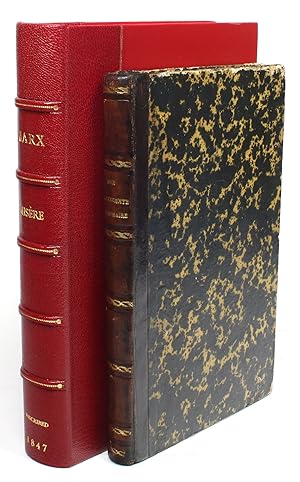
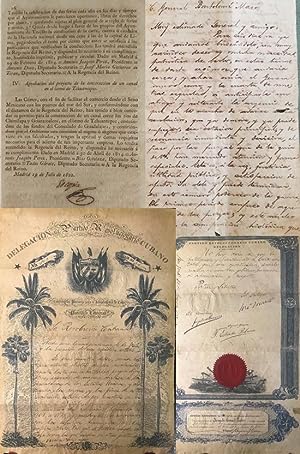
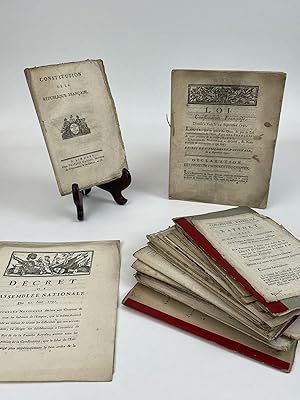

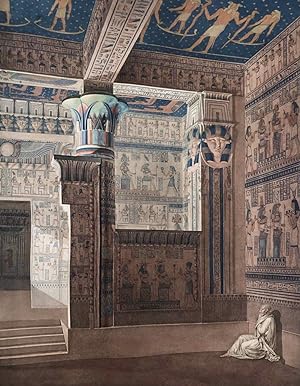
![Image du vendeur pour Der 18the Brumaire des Louis Napoleon [in: Die Revolution, eine Zeitschrift in zwanglosen Heften. Herausgegeben von J. Weydemeyer. Erstes Heft]. - [THE MOST IMPORTANT PROPOSITIONS IN THE MARXIST TEACHING ON THE STATE] mis en vente par Lynge & Søn ILAB-ABF](https://pictures.abebooks.com/inventory/md/md30602425307.jpg)

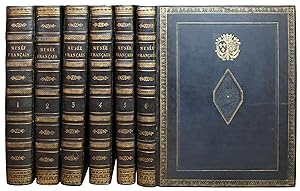
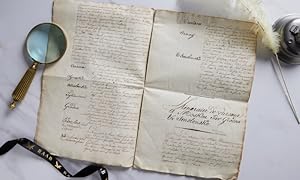
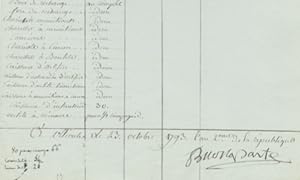

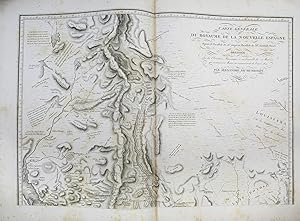
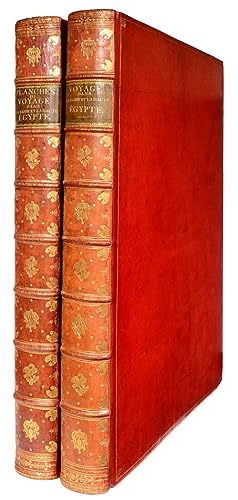
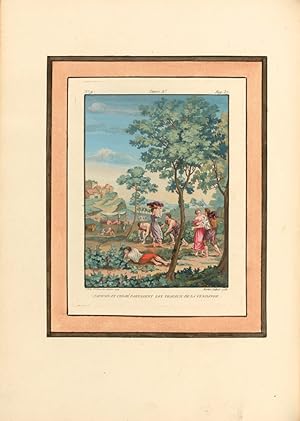

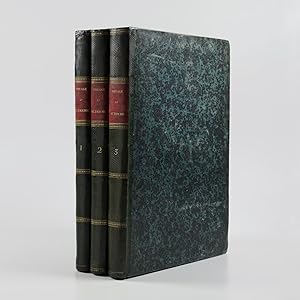
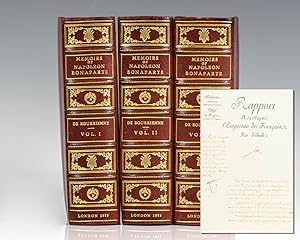
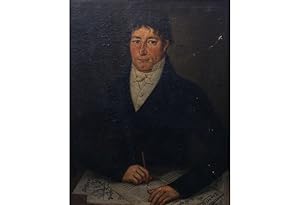
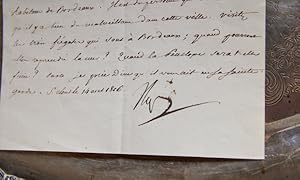
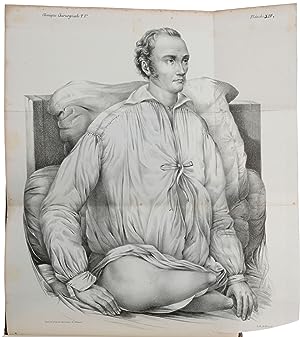
![Image du vendeur pour Los desastres de la guerra. Colección de ochenta láminas inventadas y grabadas al agua-fuerte. Publicala la Real Academia de Bellas Artes de San Fernando. - ["THE MOST SEARING WORKS OF ART EVER TO DEAL WITH CONFLICT"] mis en vente par Lynge & Søn ILAB-ABF](https://pictures.abebooks.com/inventory/md/md31434126431.jpg)
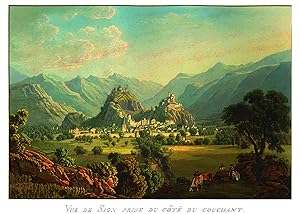
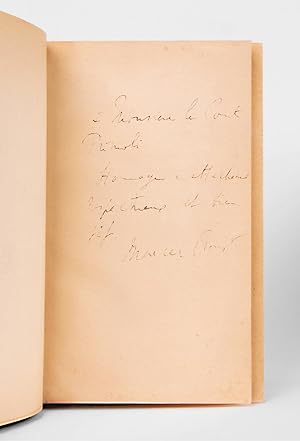

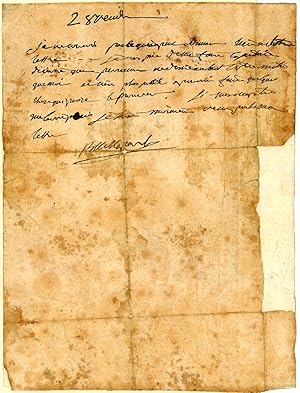

![Image du vendeur pour Proclamation aux habitans de l Egypte. Cairo, Imprimerie Nationale, 6 brumaire an 9 [28 October 1800 CE]. Folio (141 x 42.5 cm). Five small oblong sheets, printed in French and Arabic in parallel columns, pasted together one above the other to form a single long broadside. mis en vente par Antiquariaat FORUM BV](https://pictures.abebooks.com/inventory/md/md31758399342.jpg)
